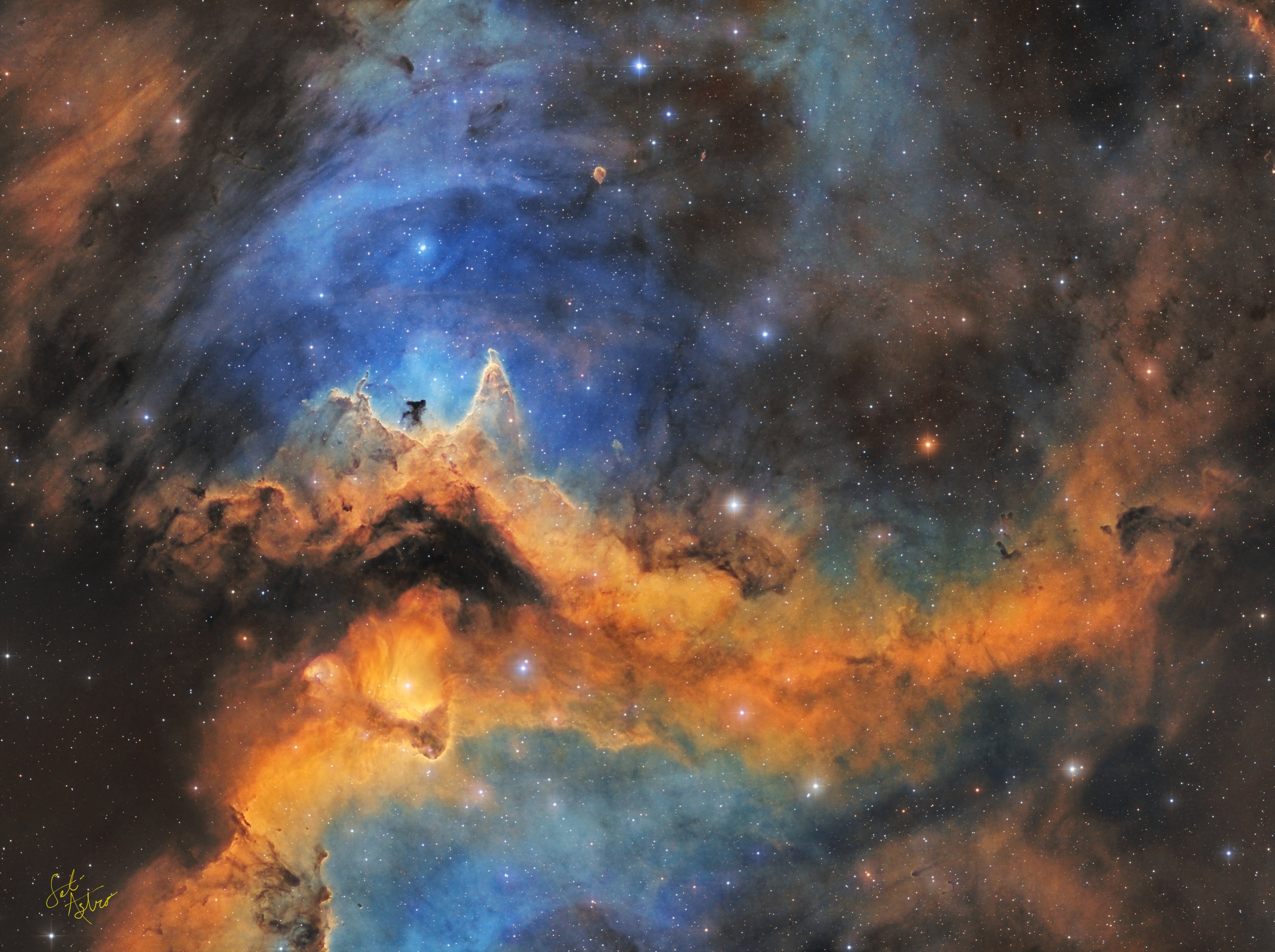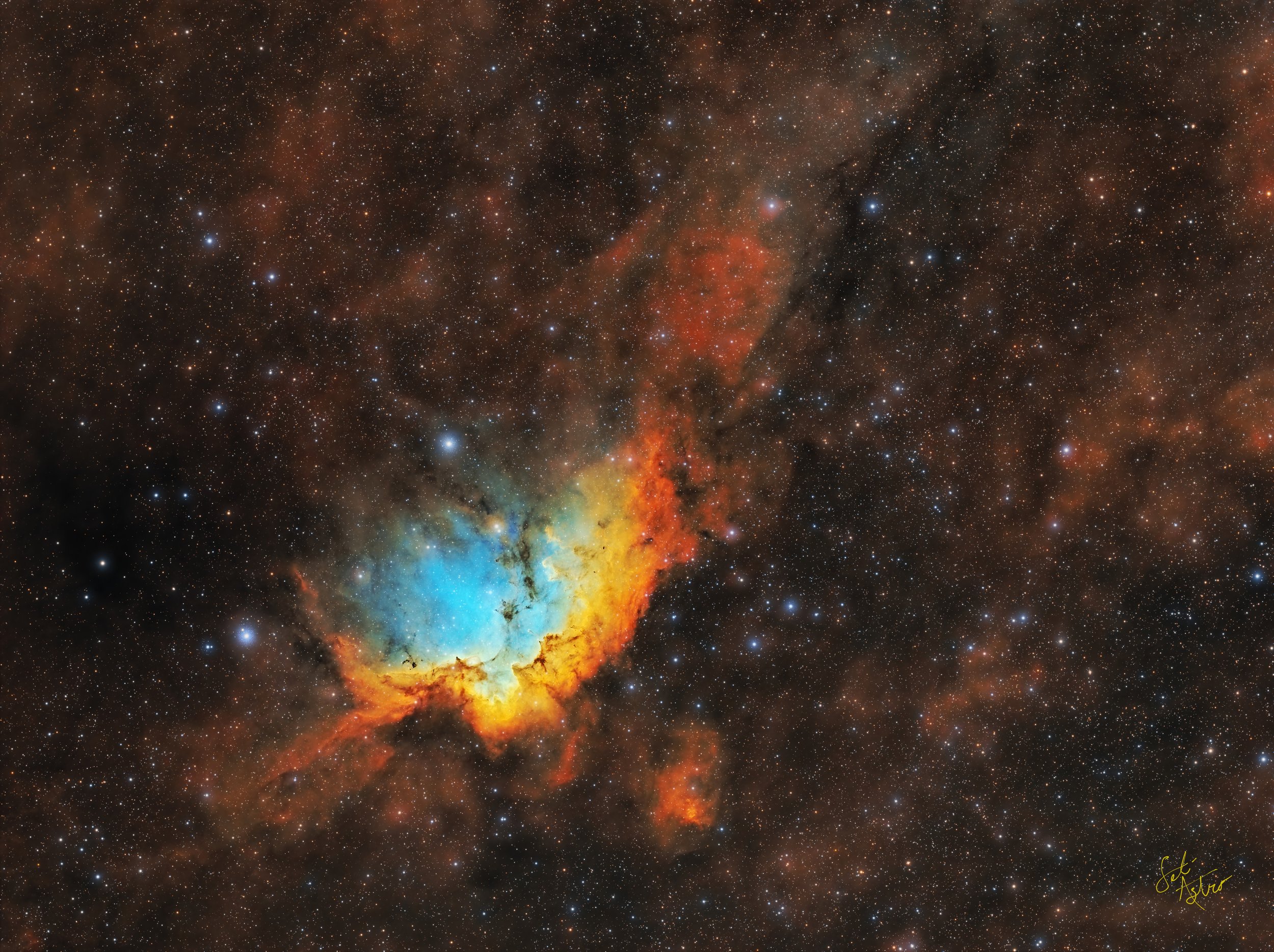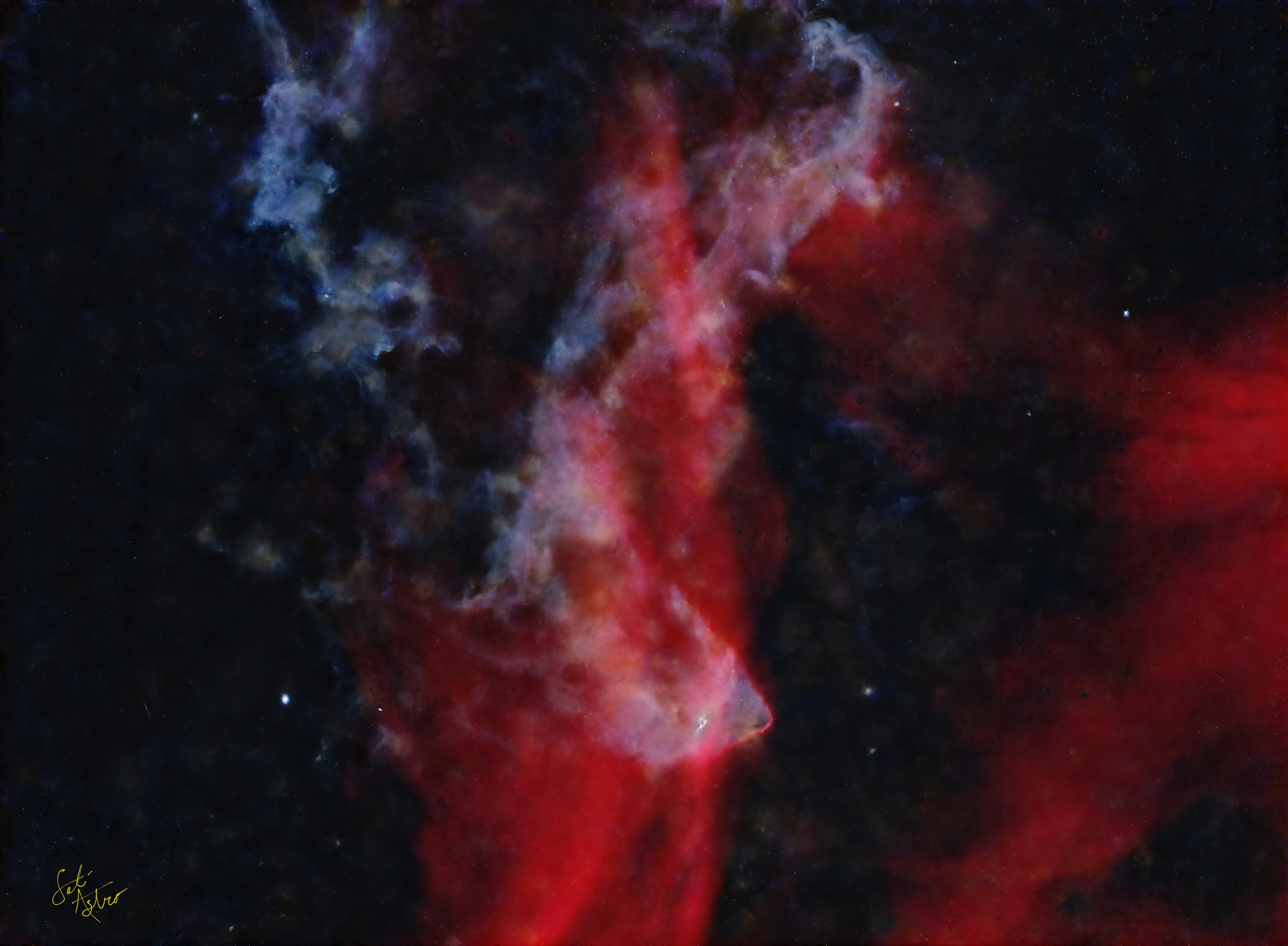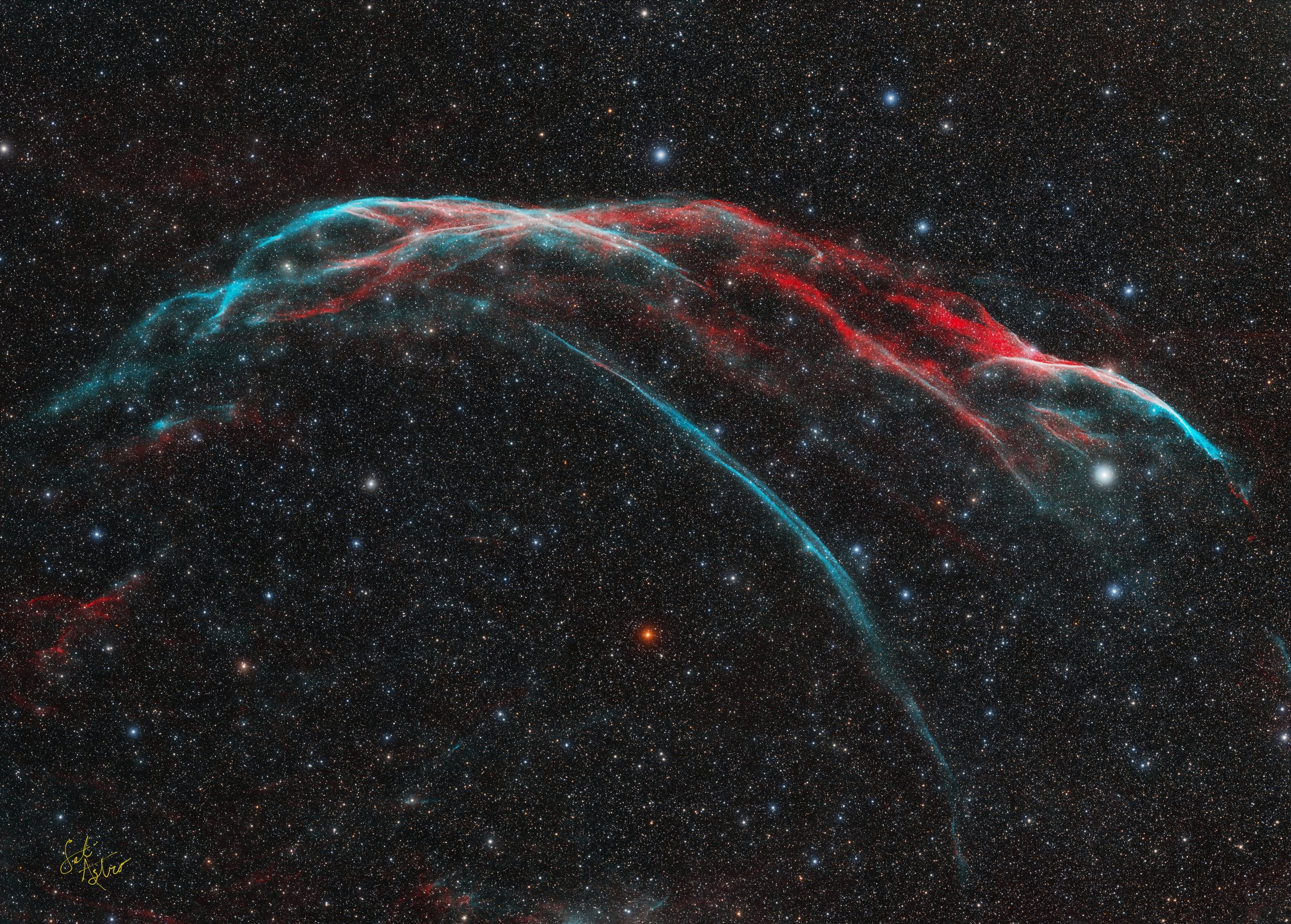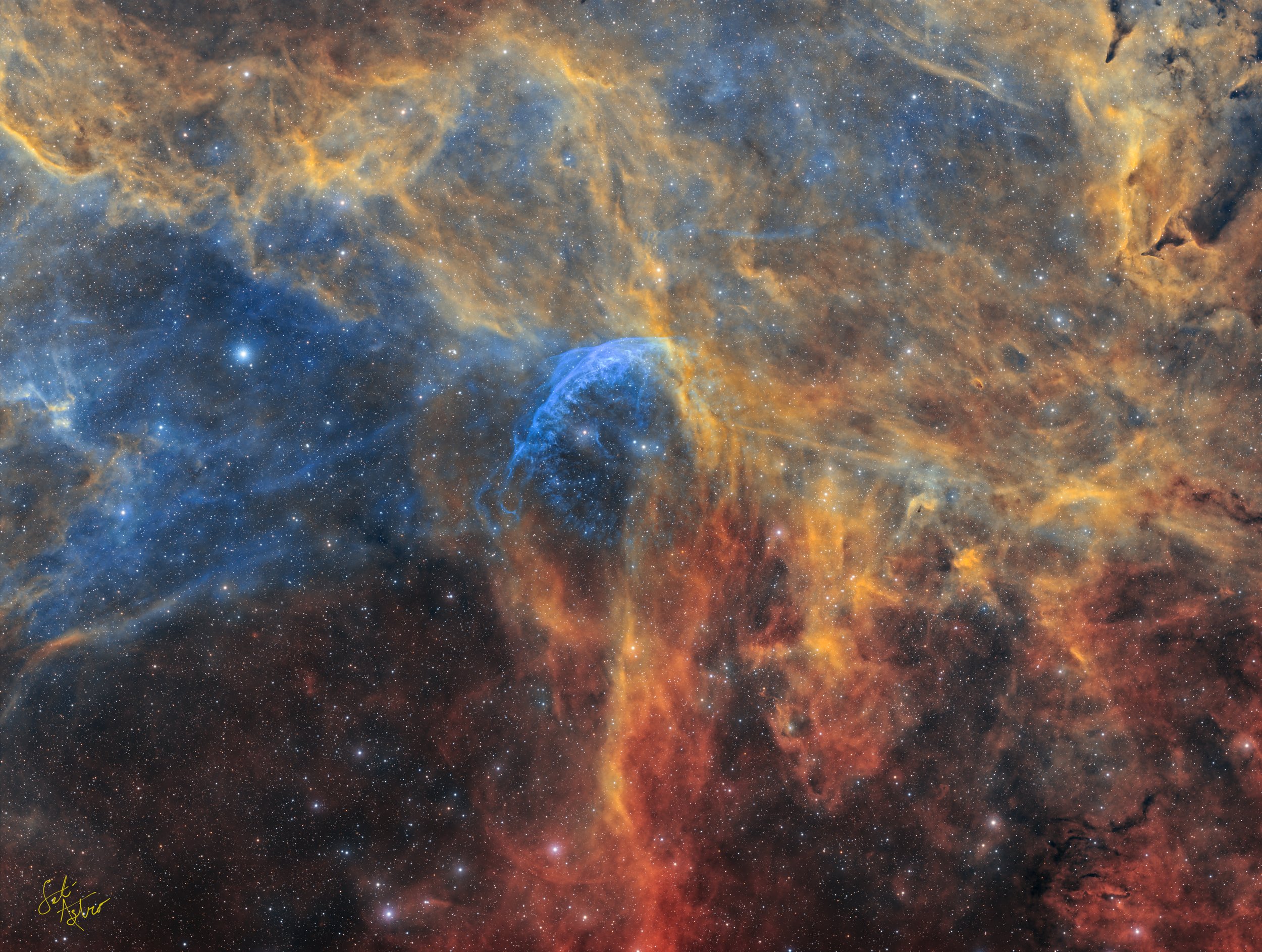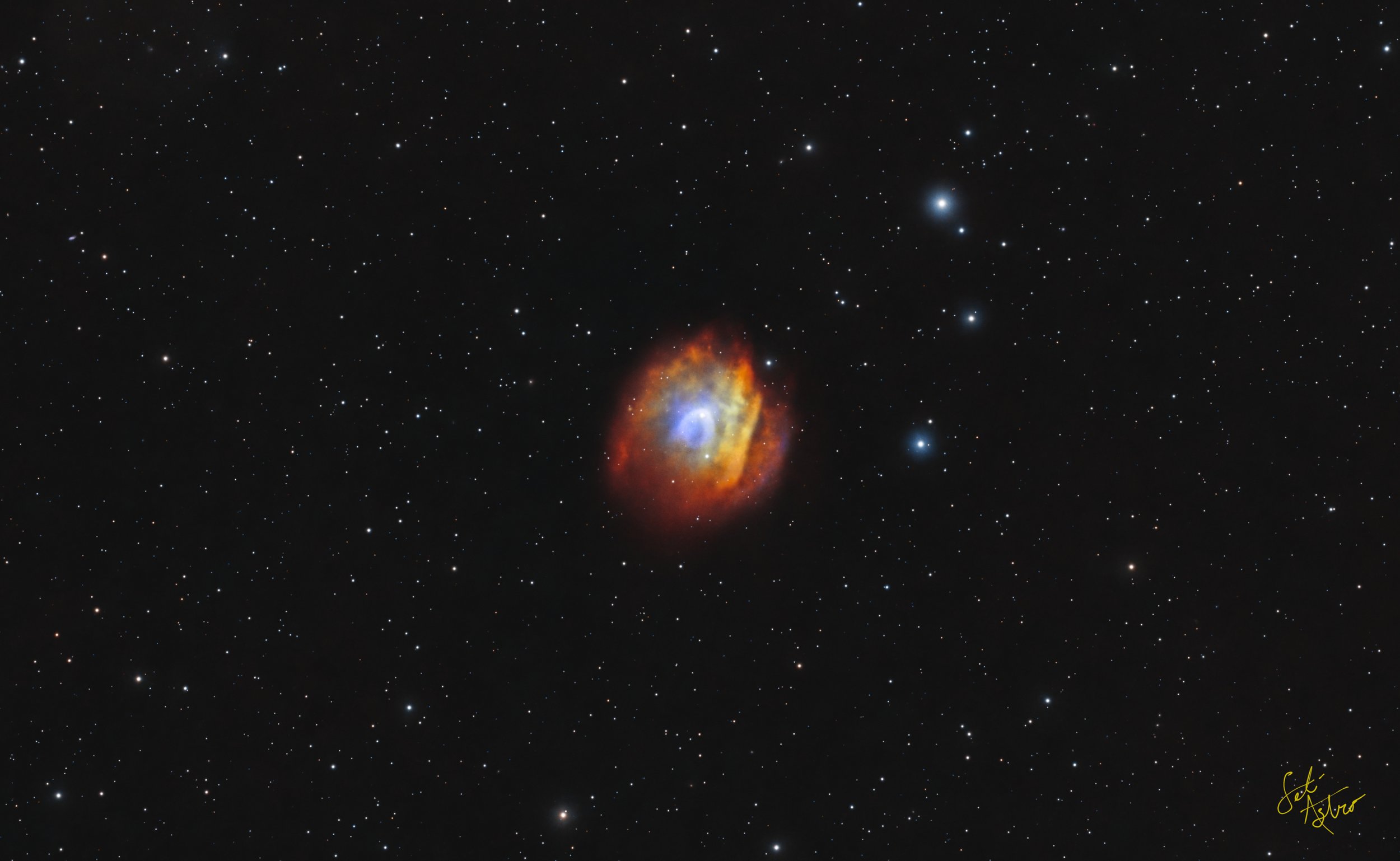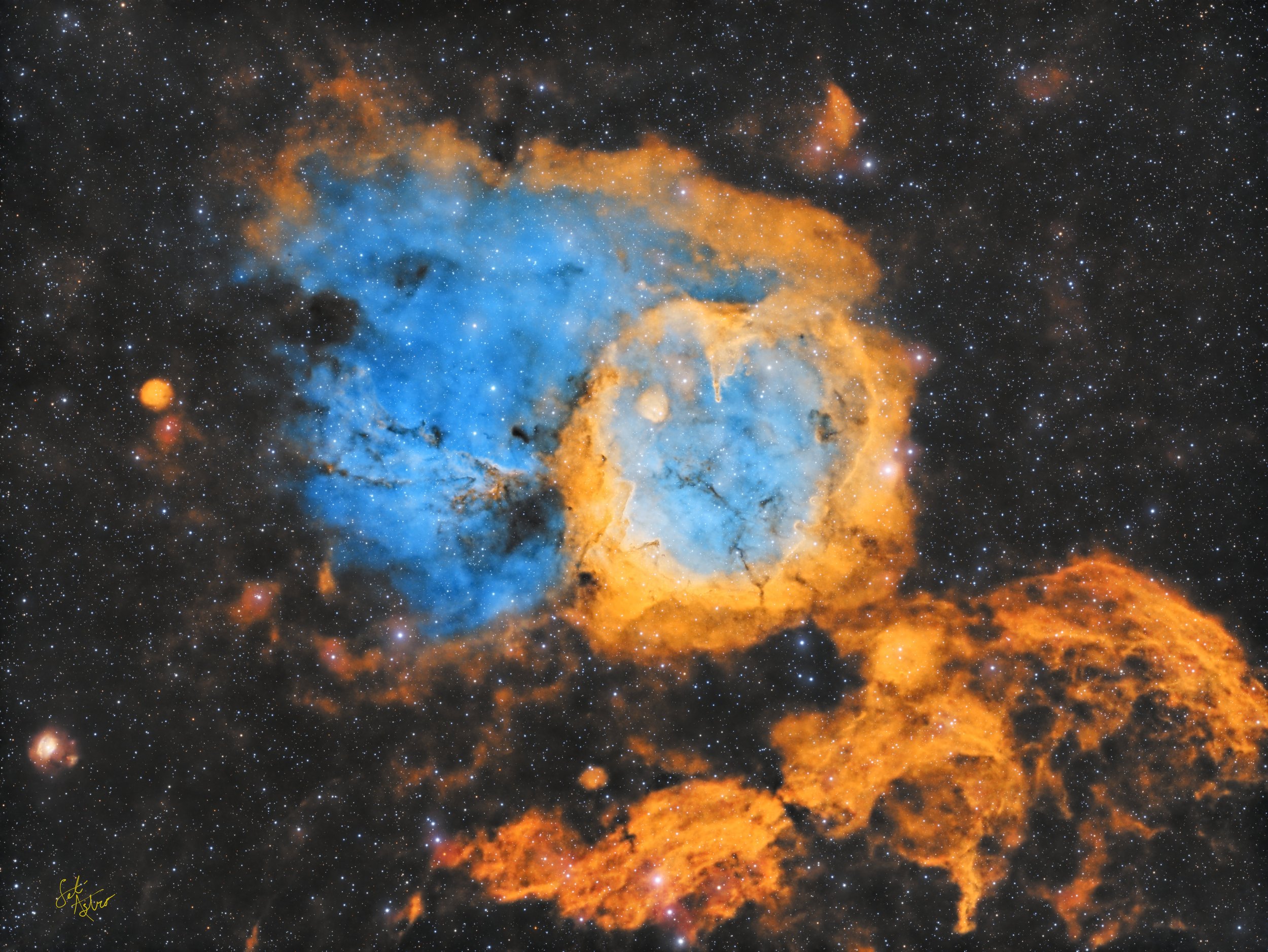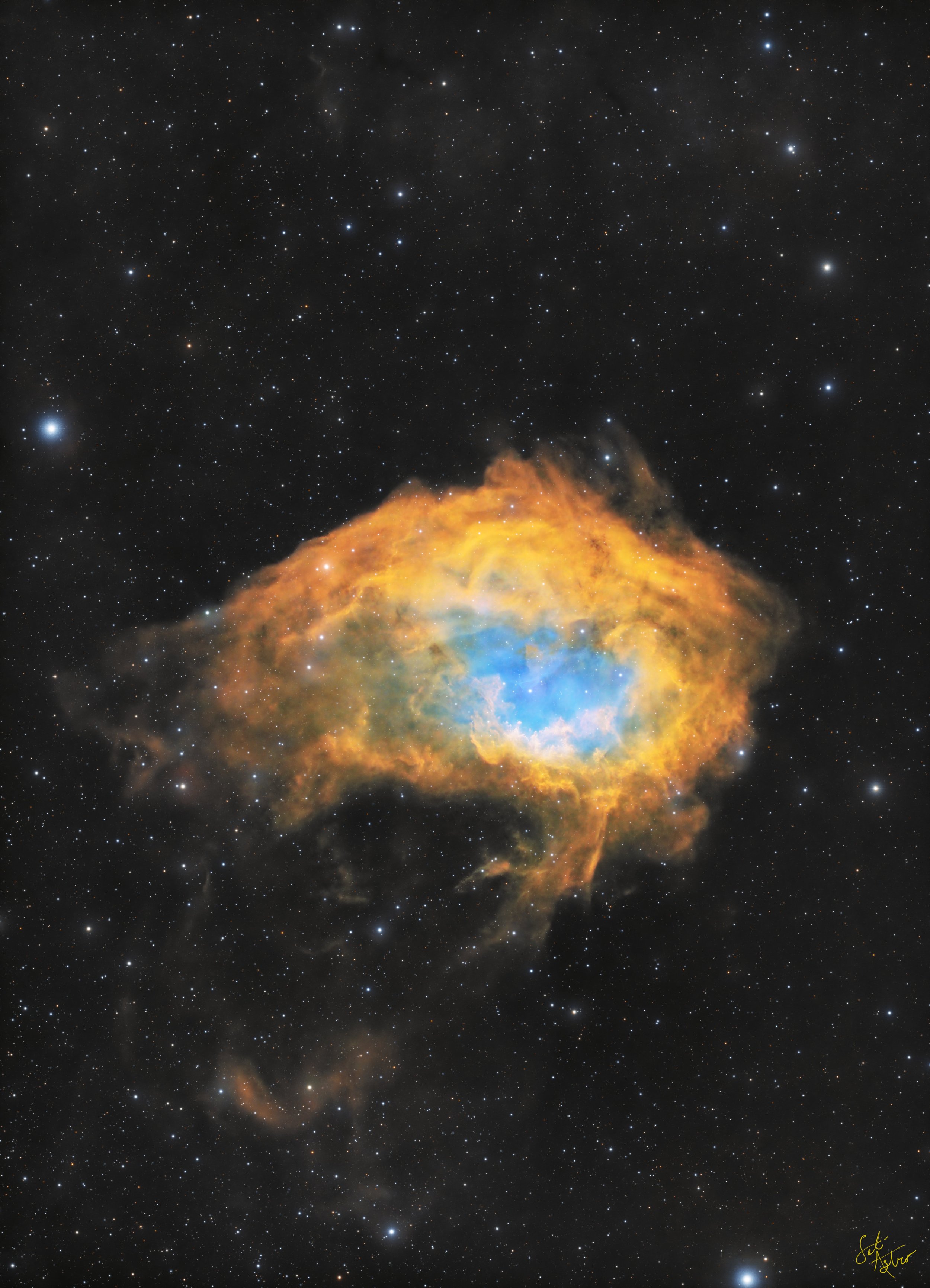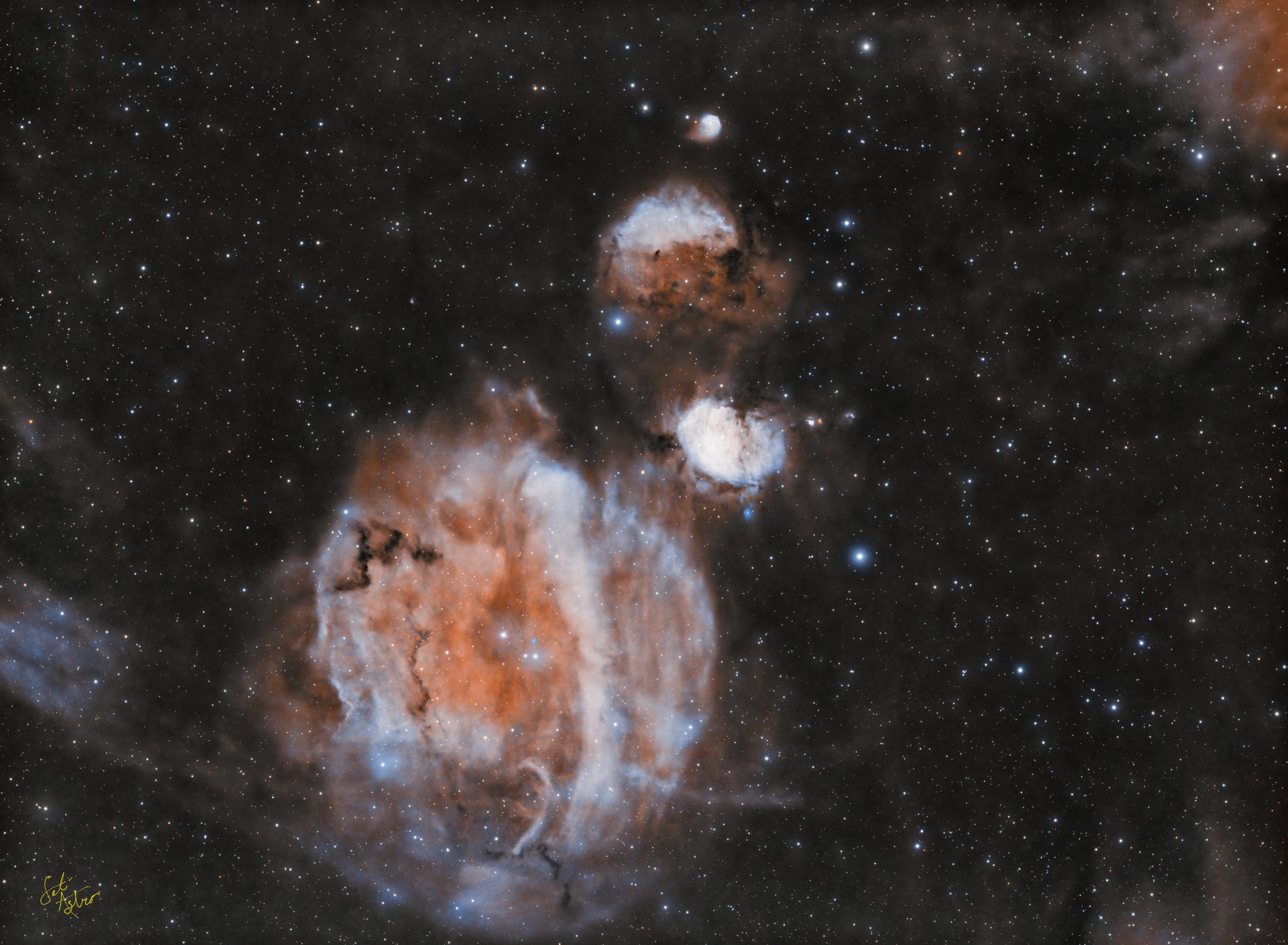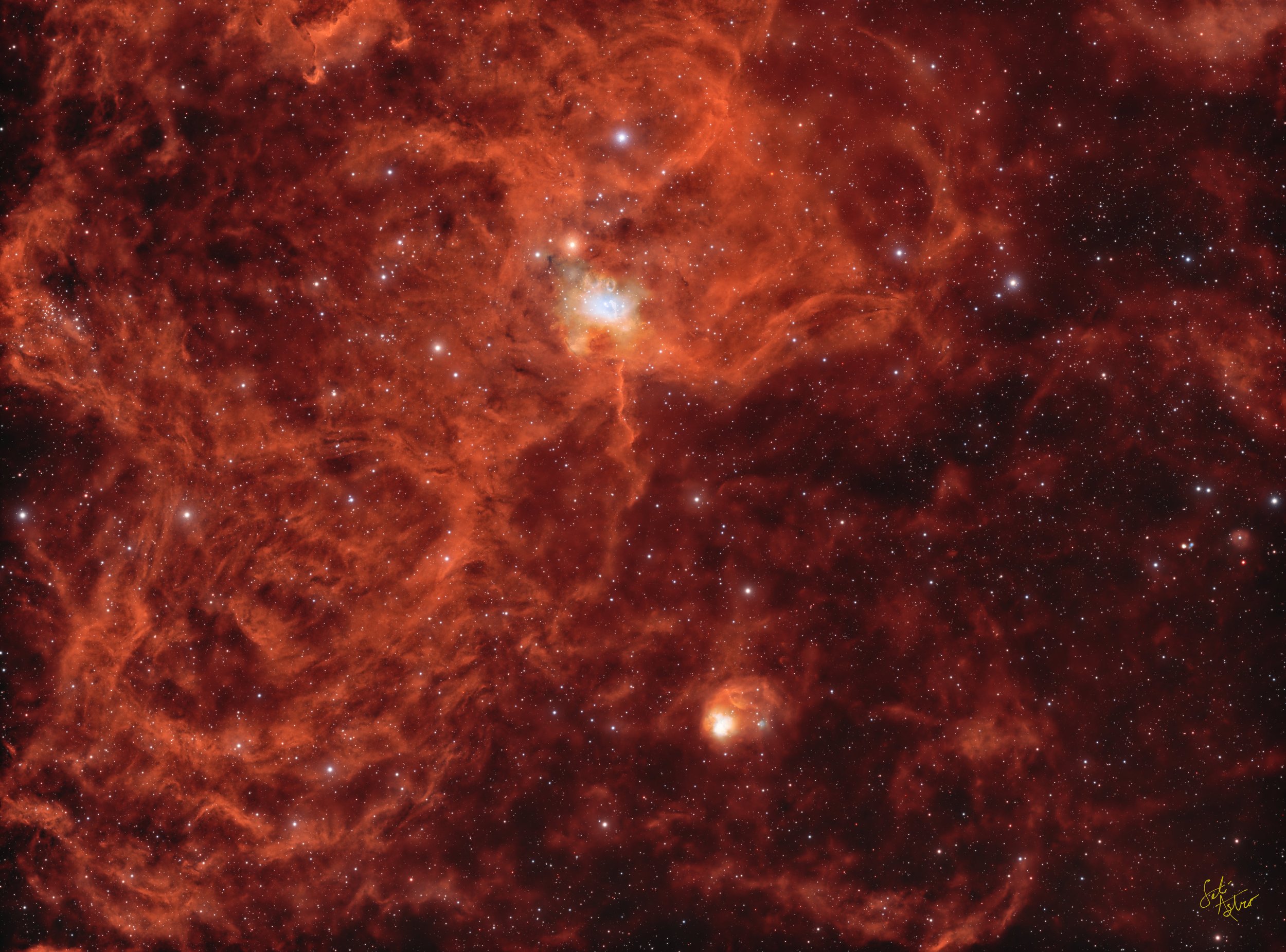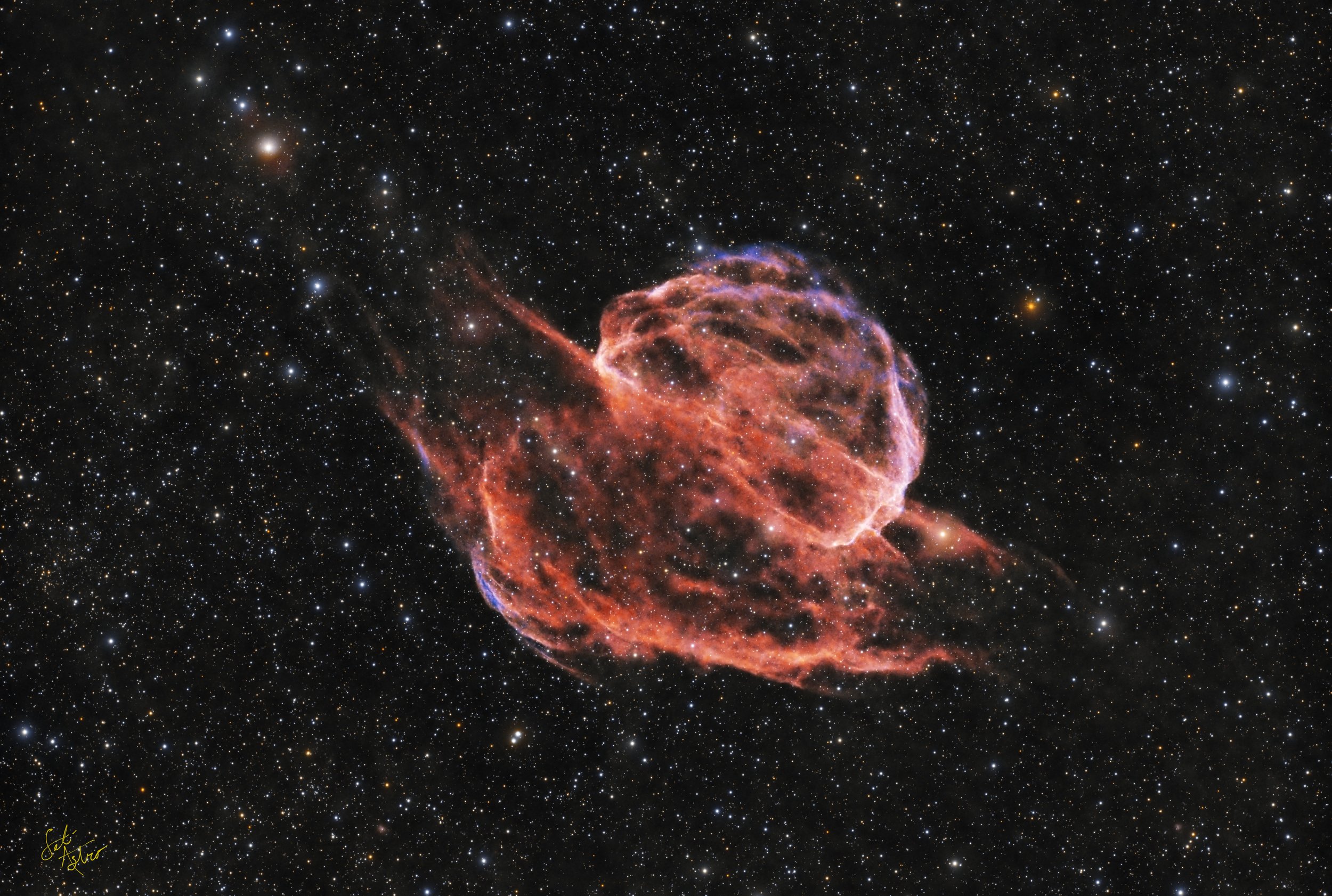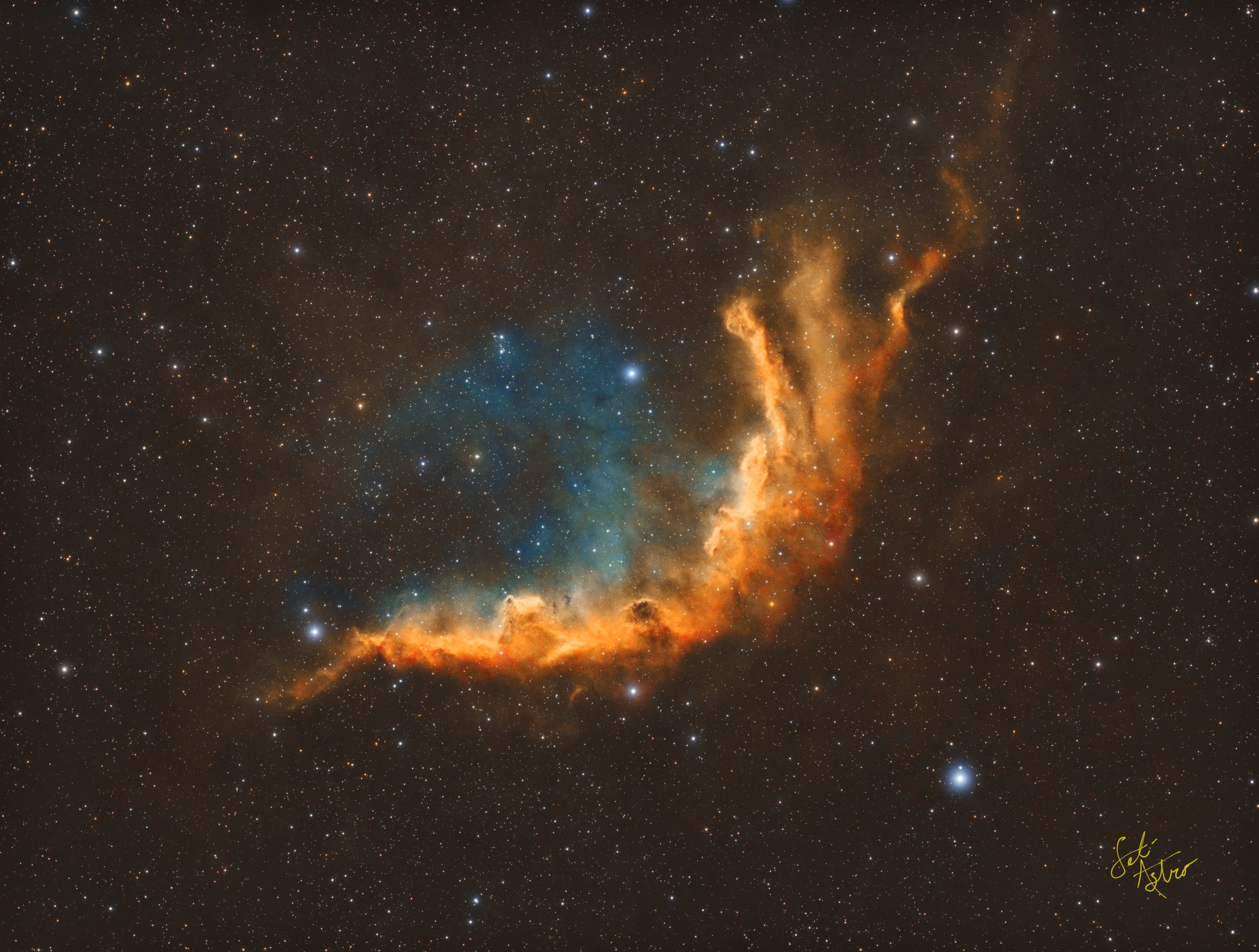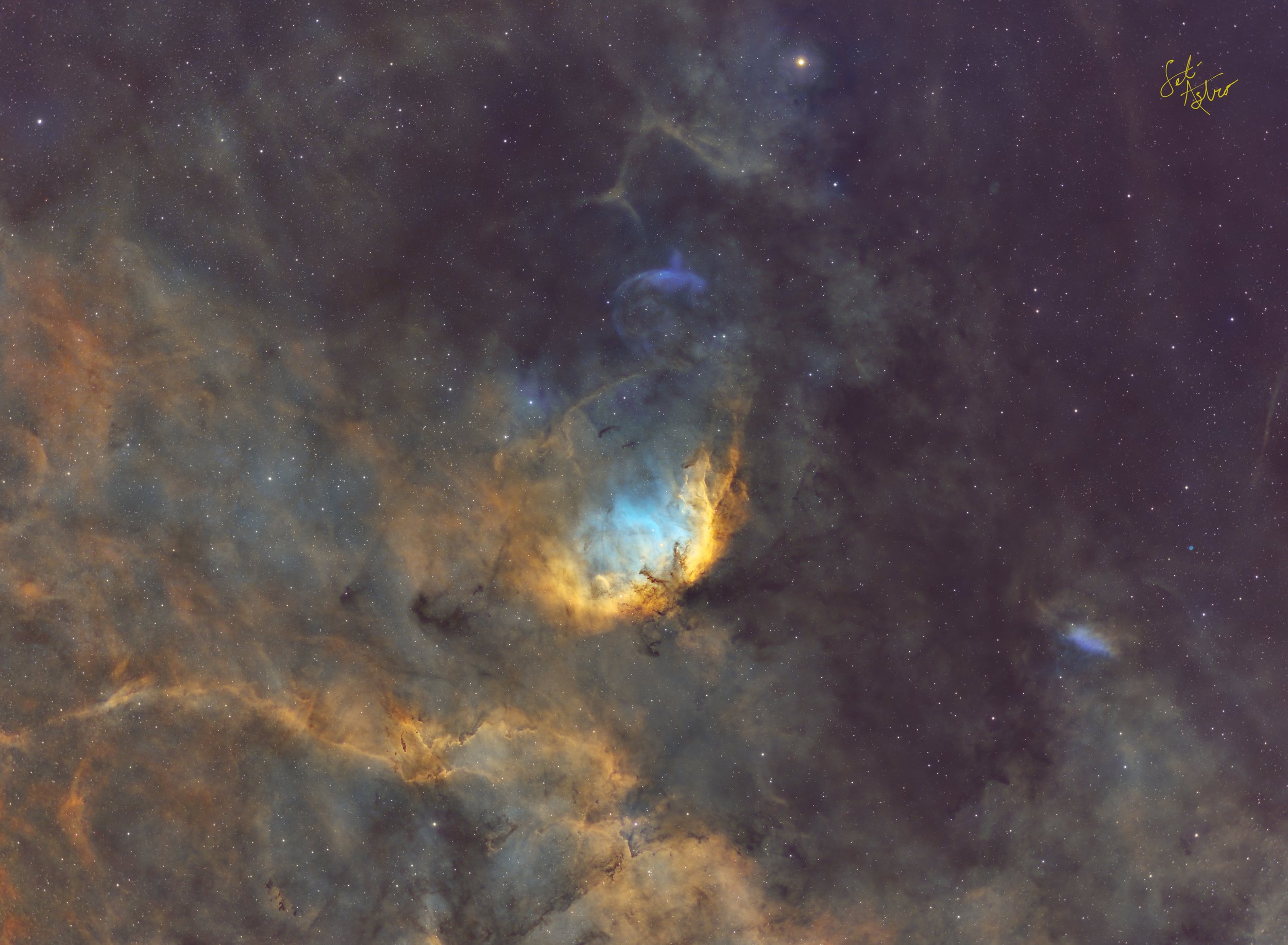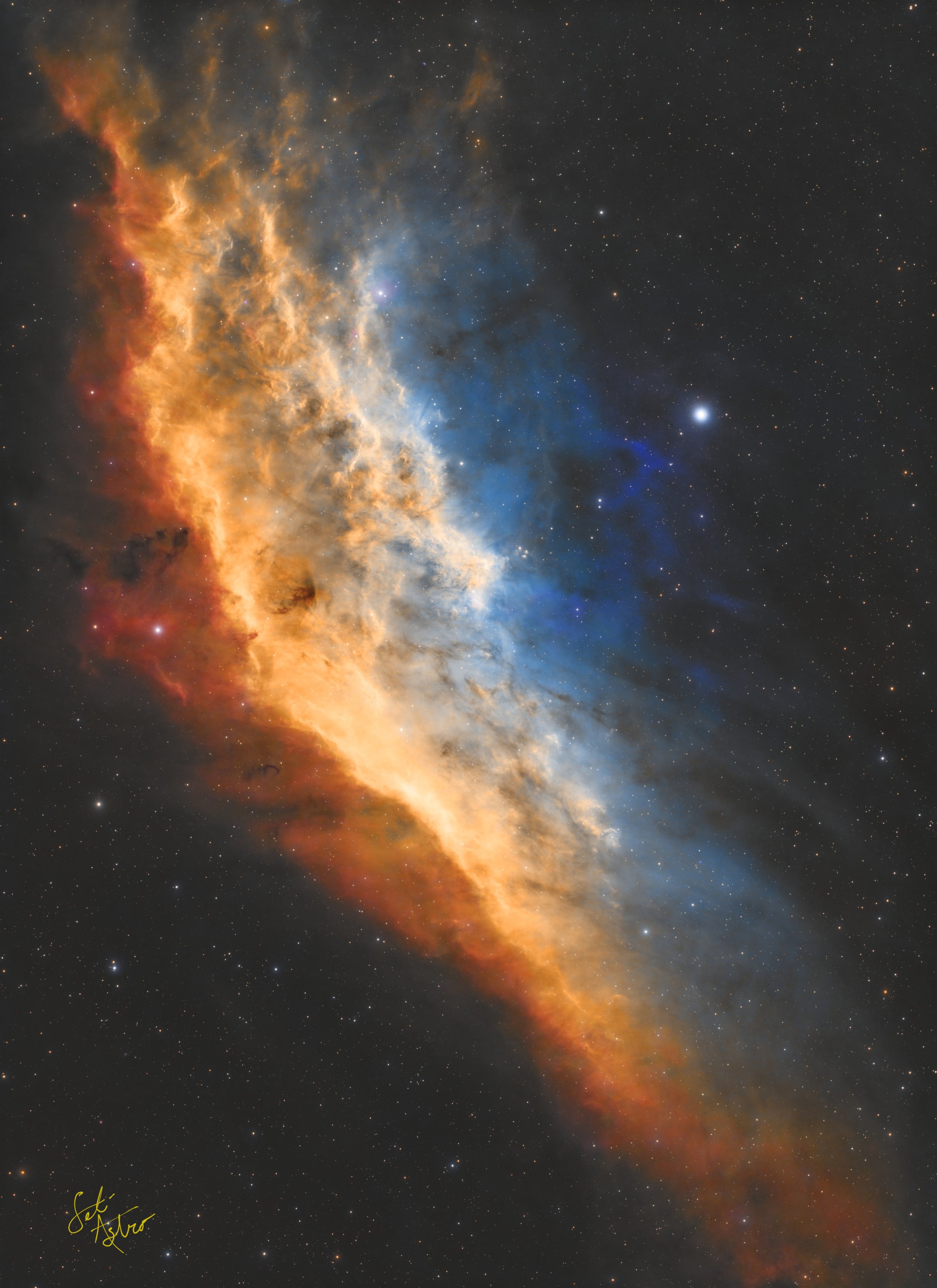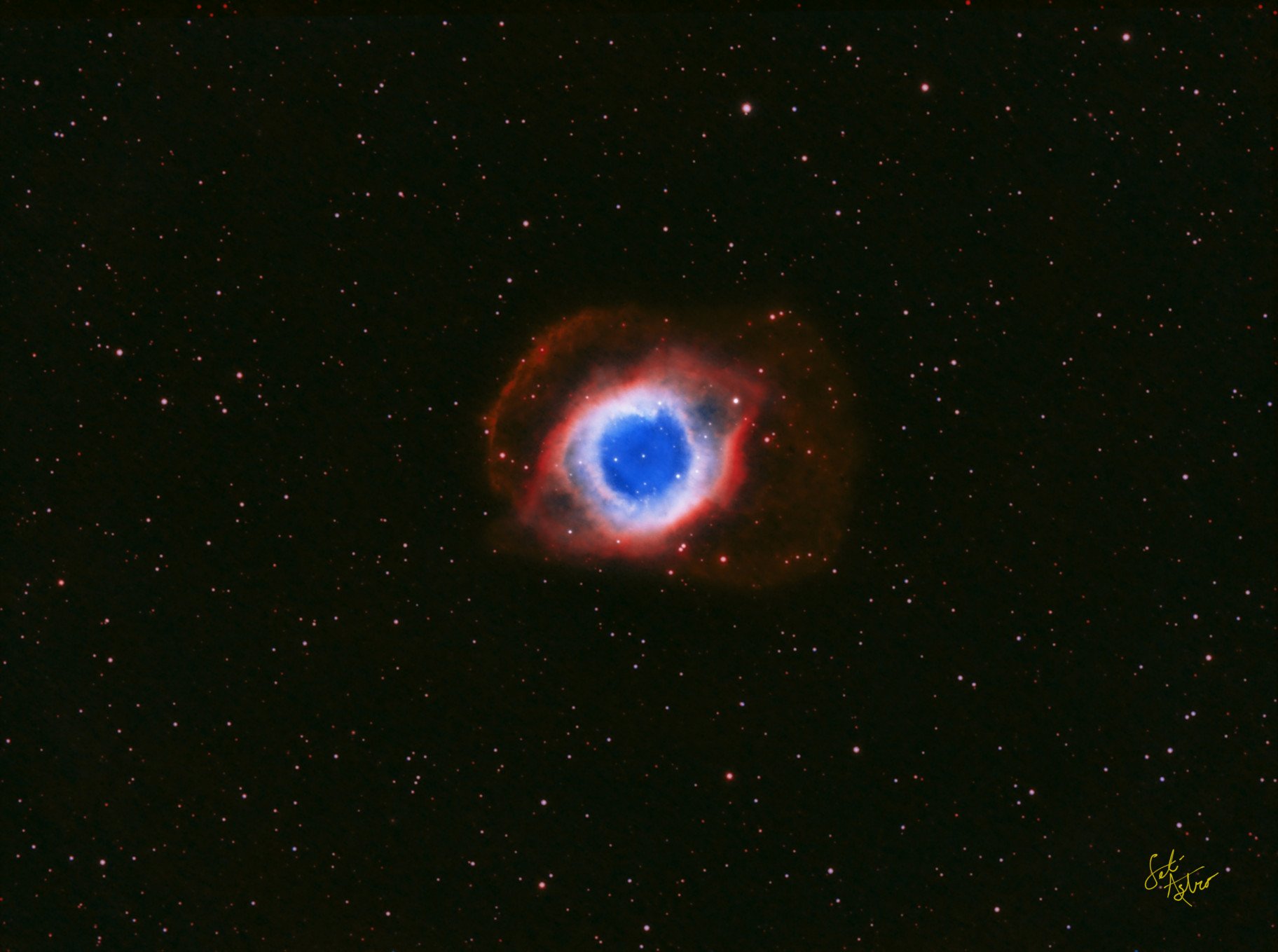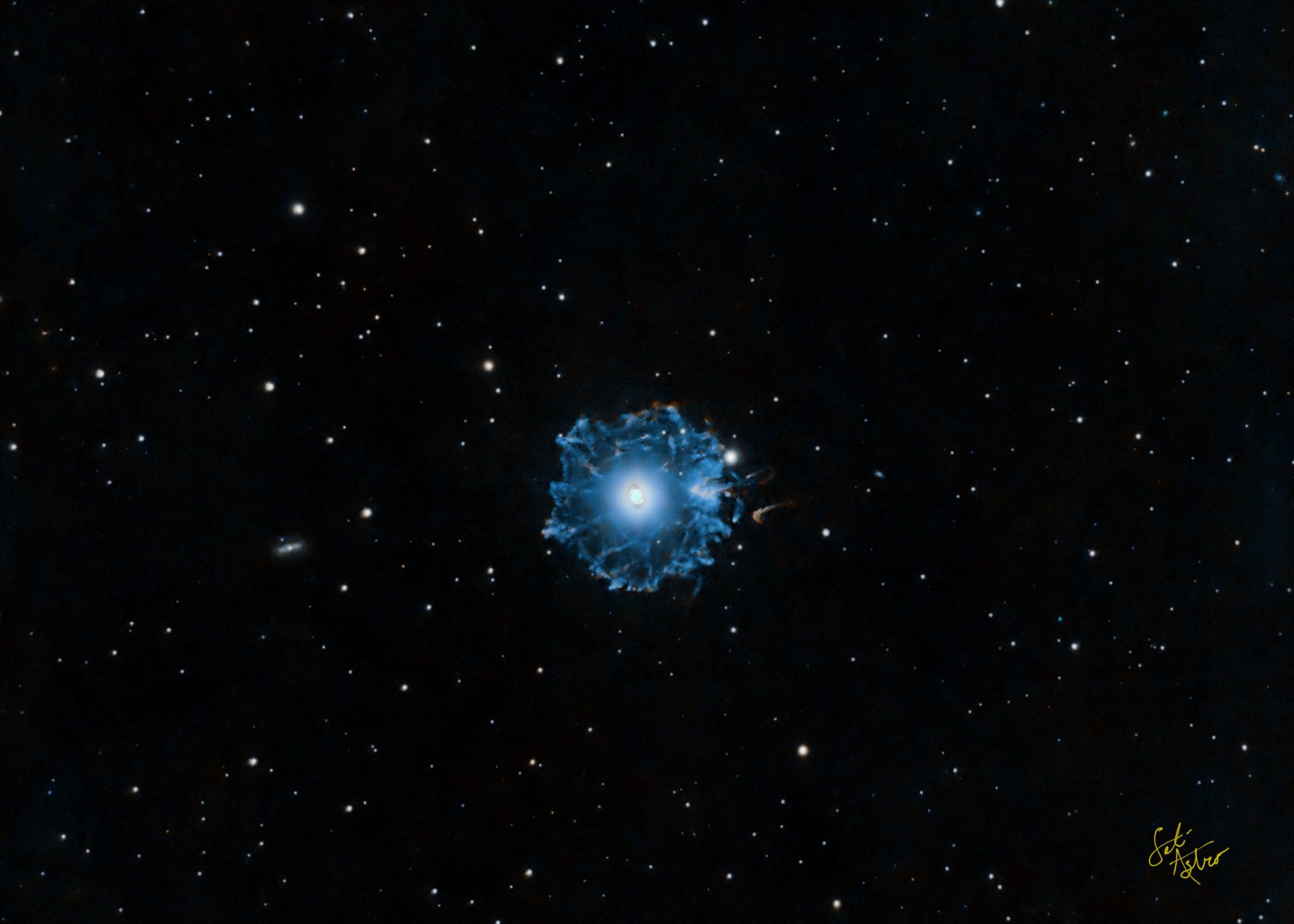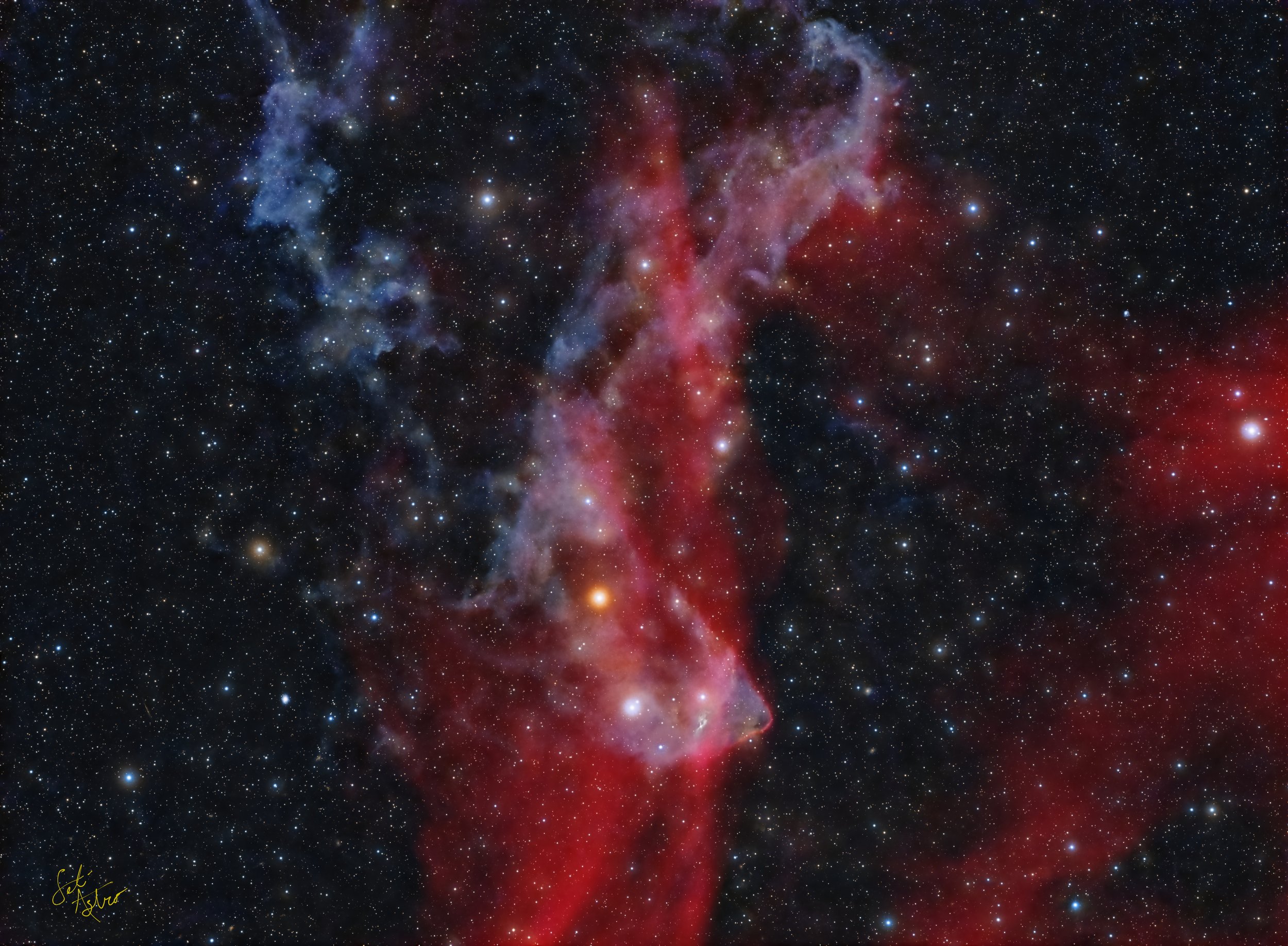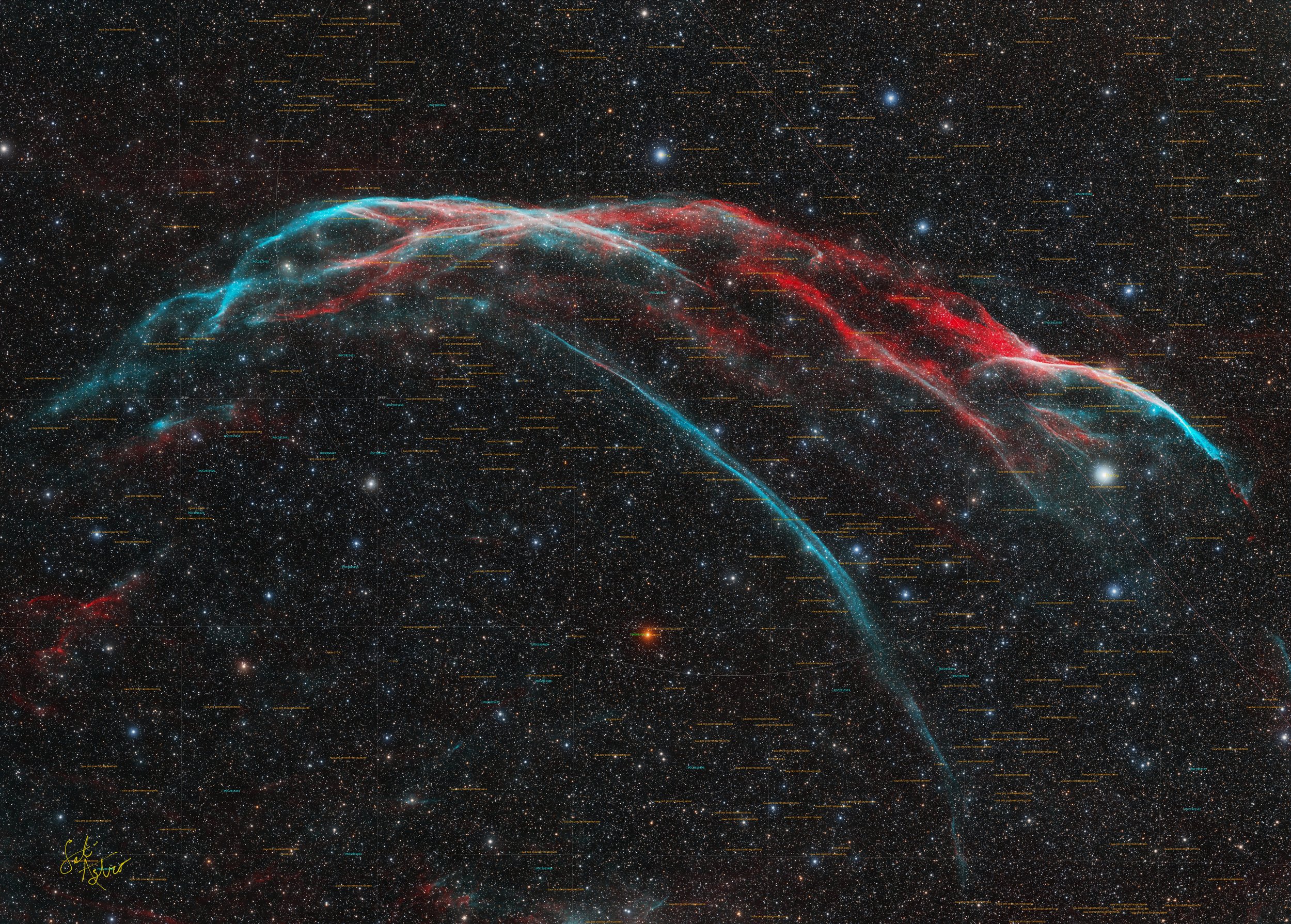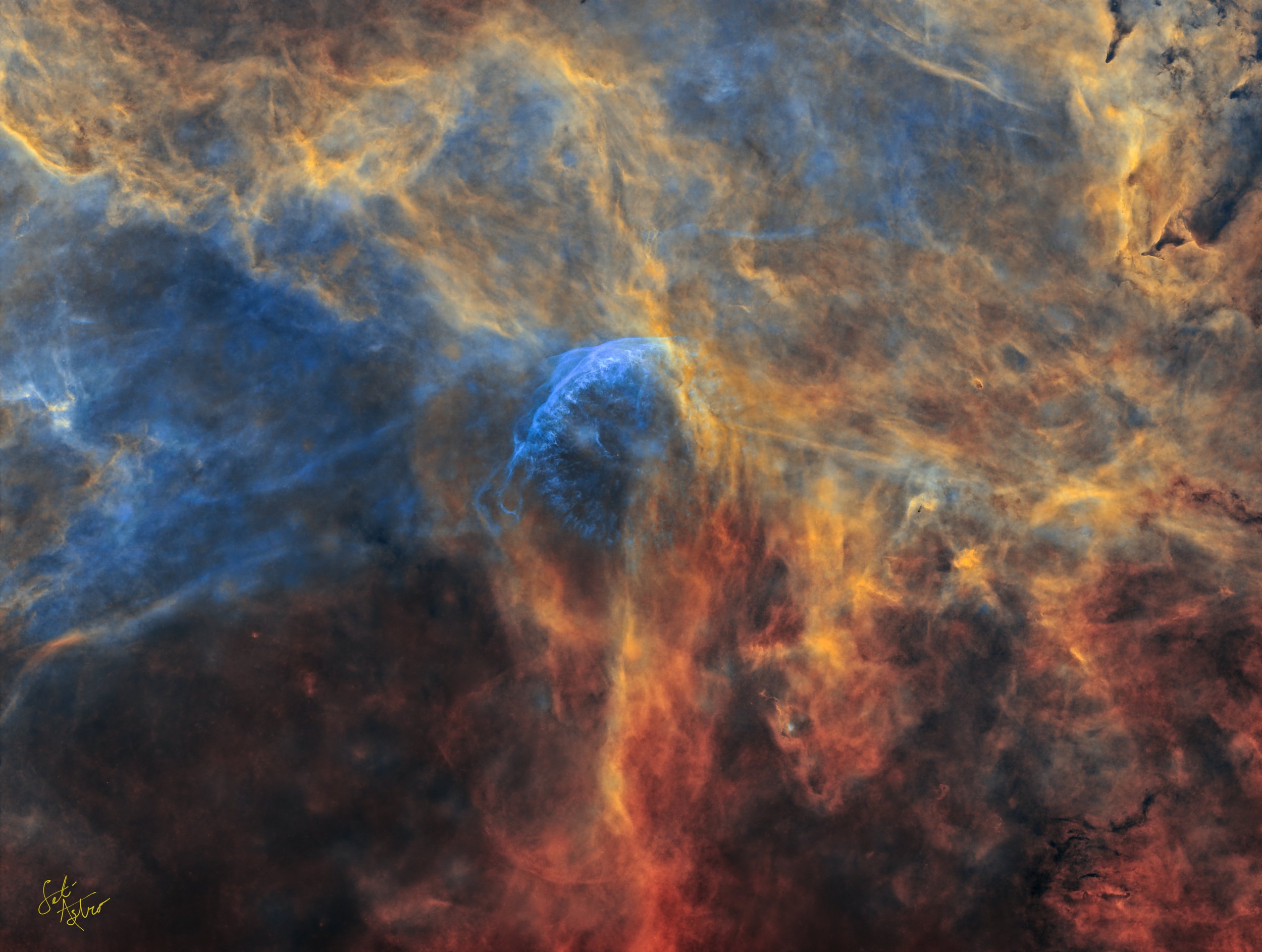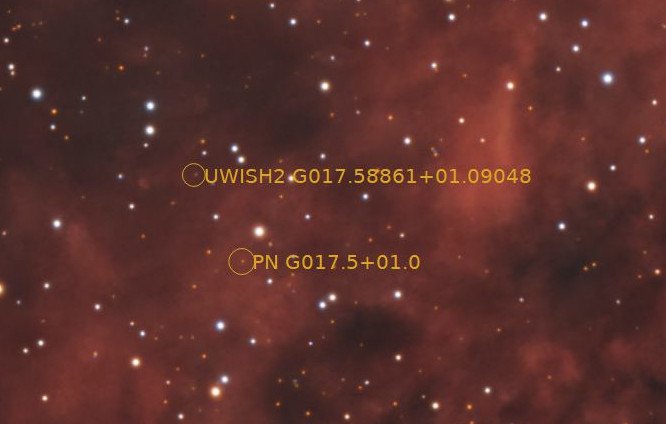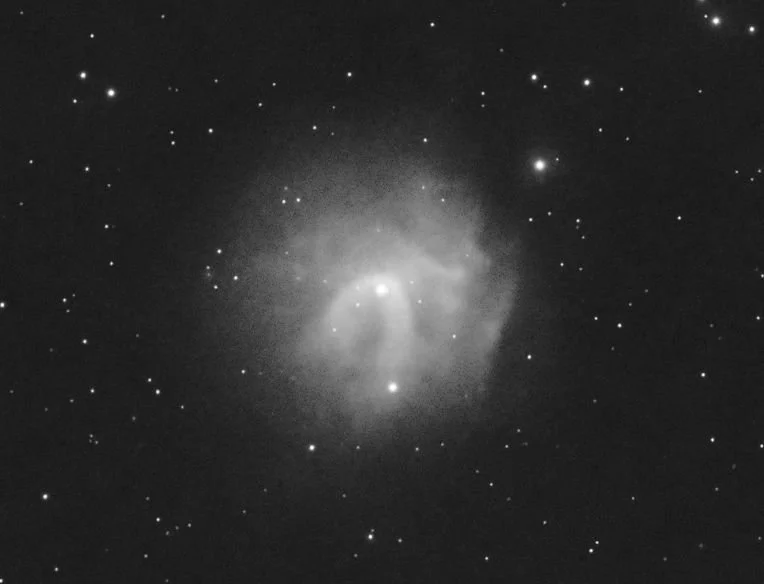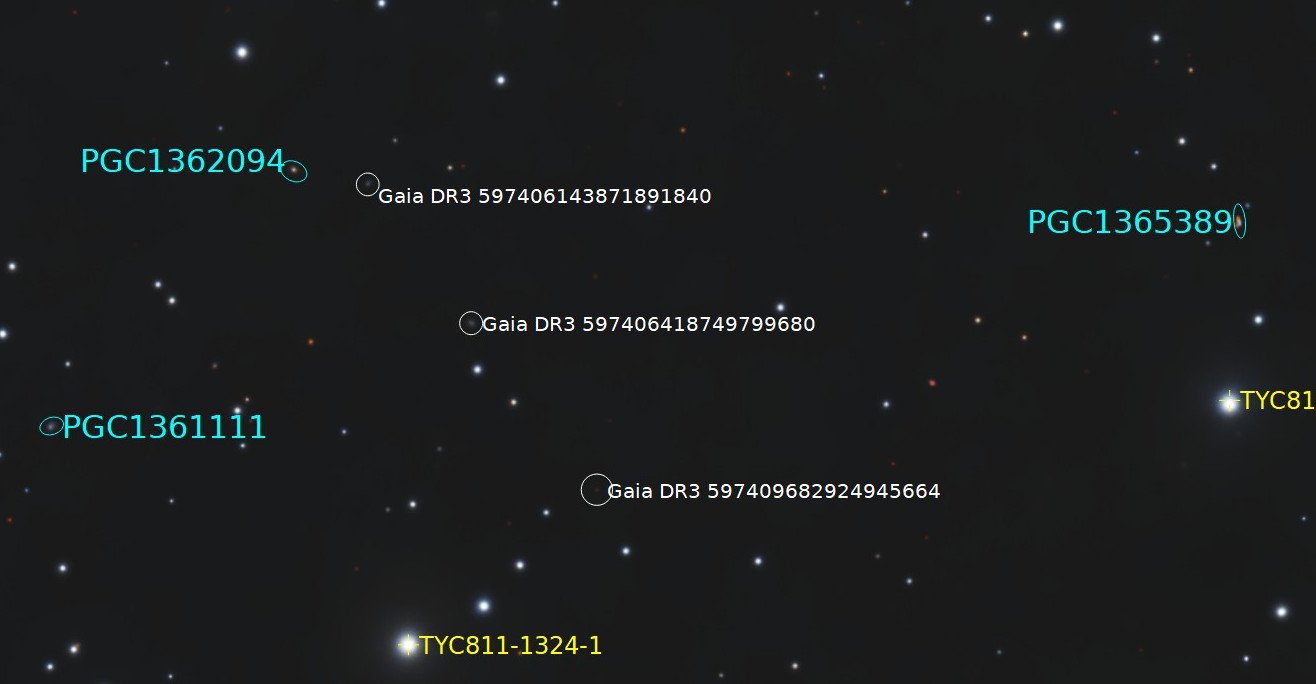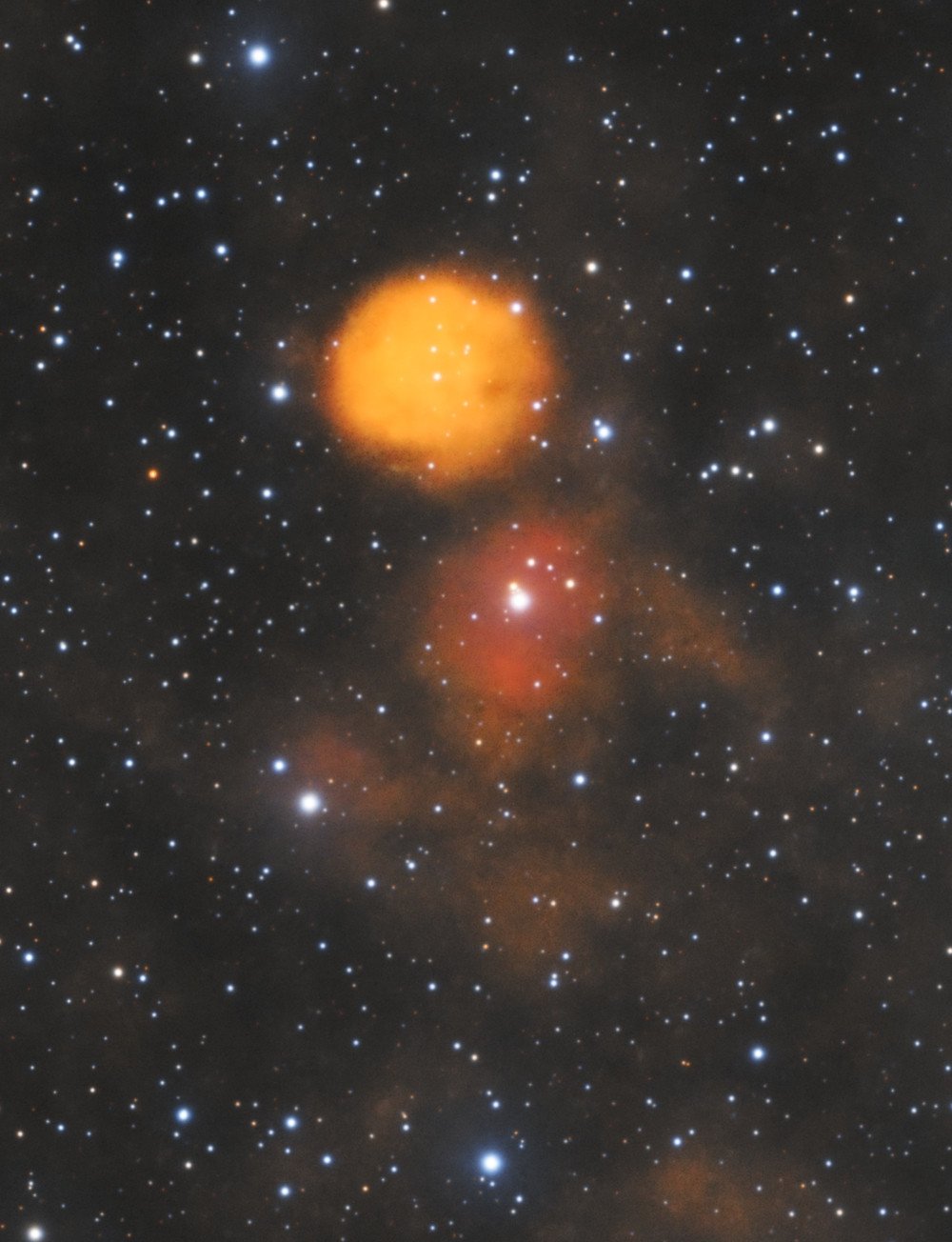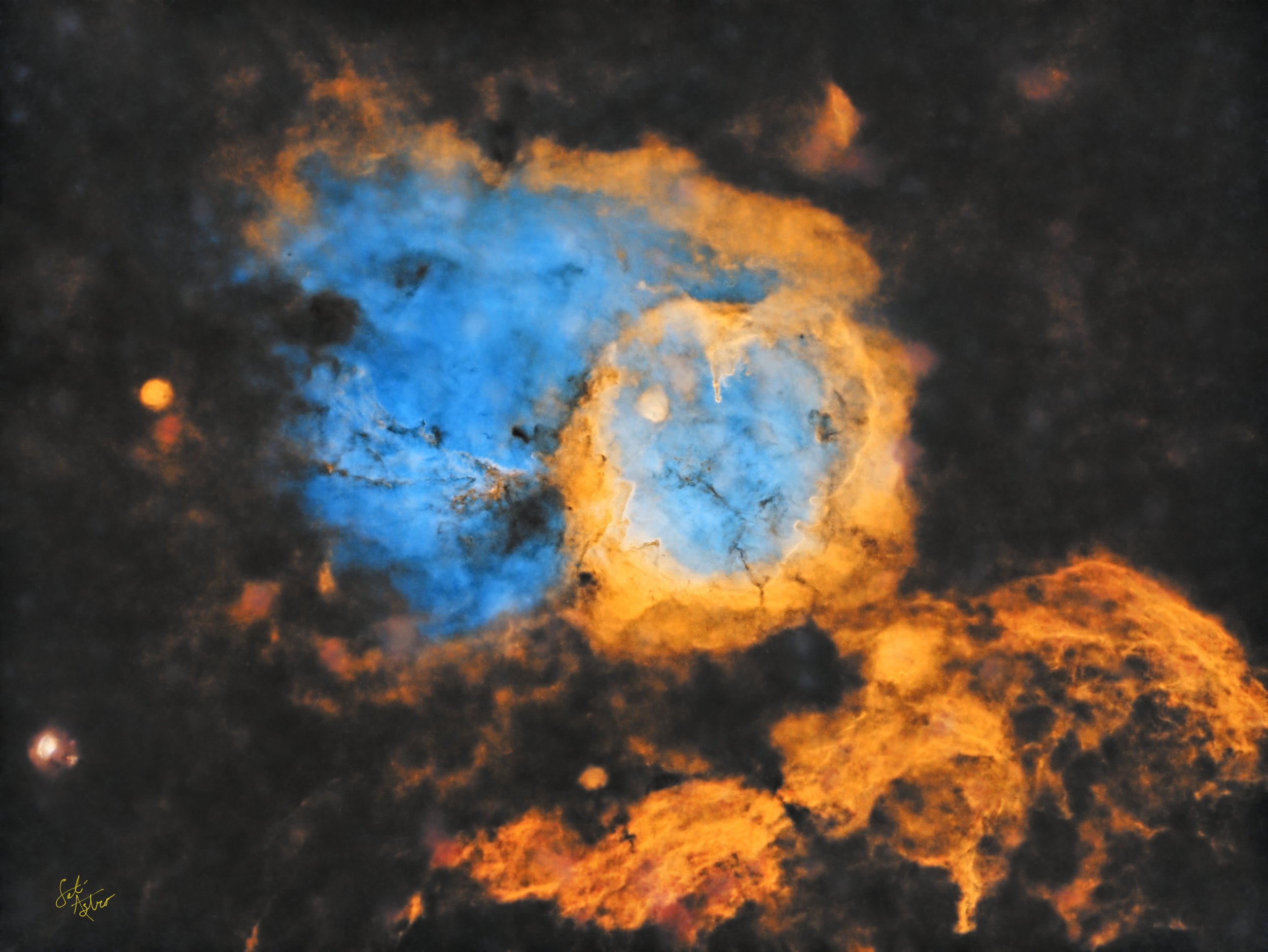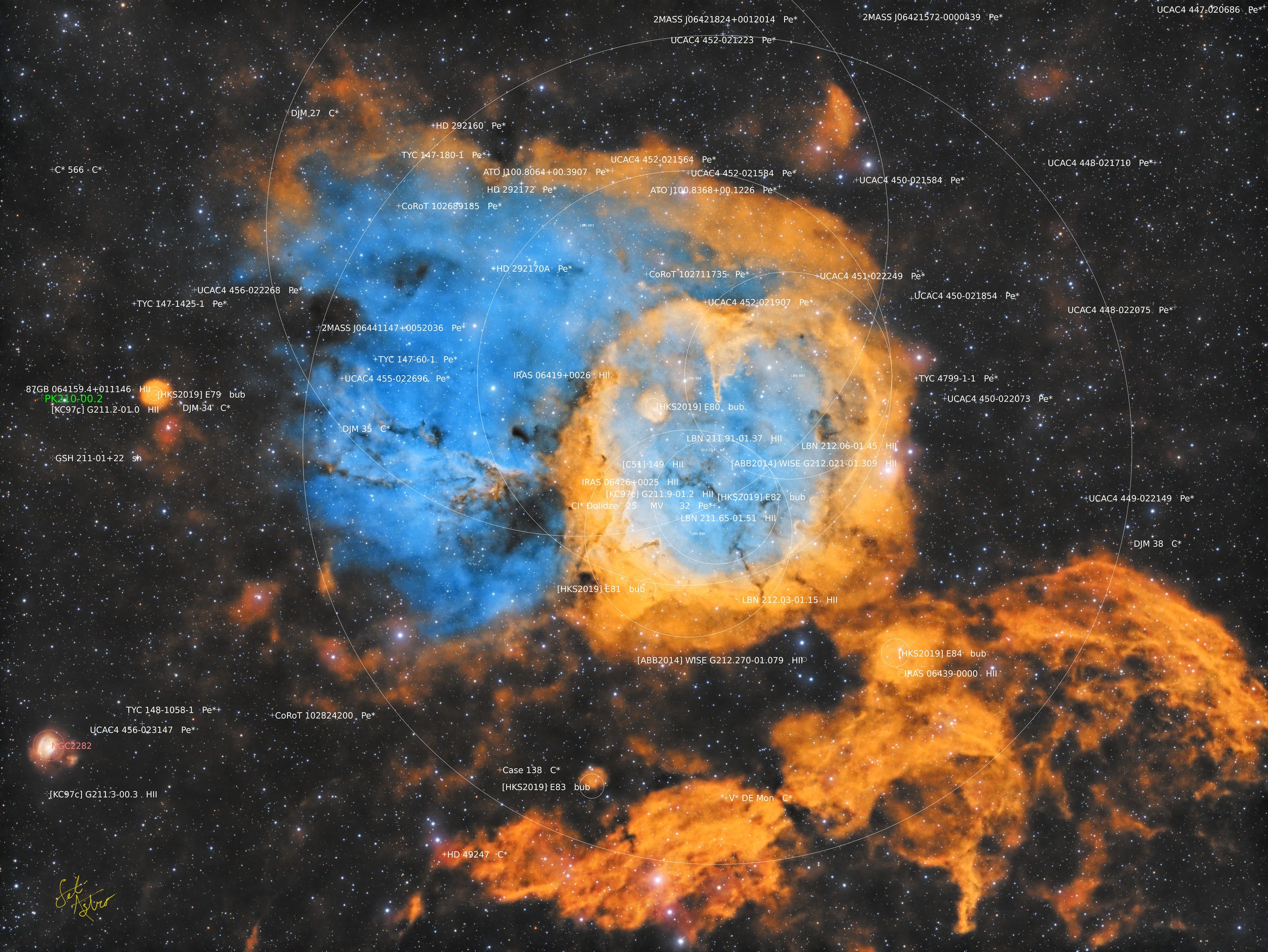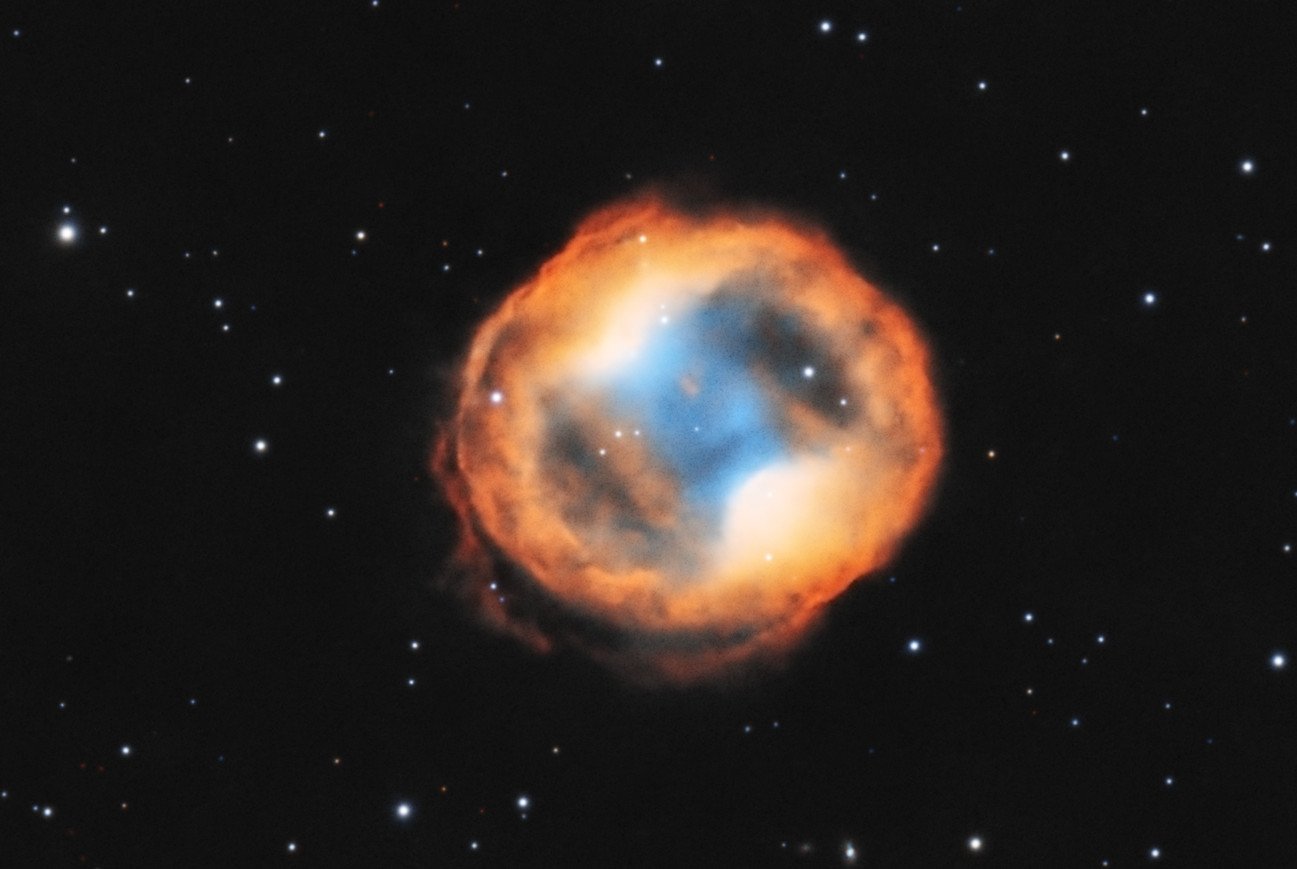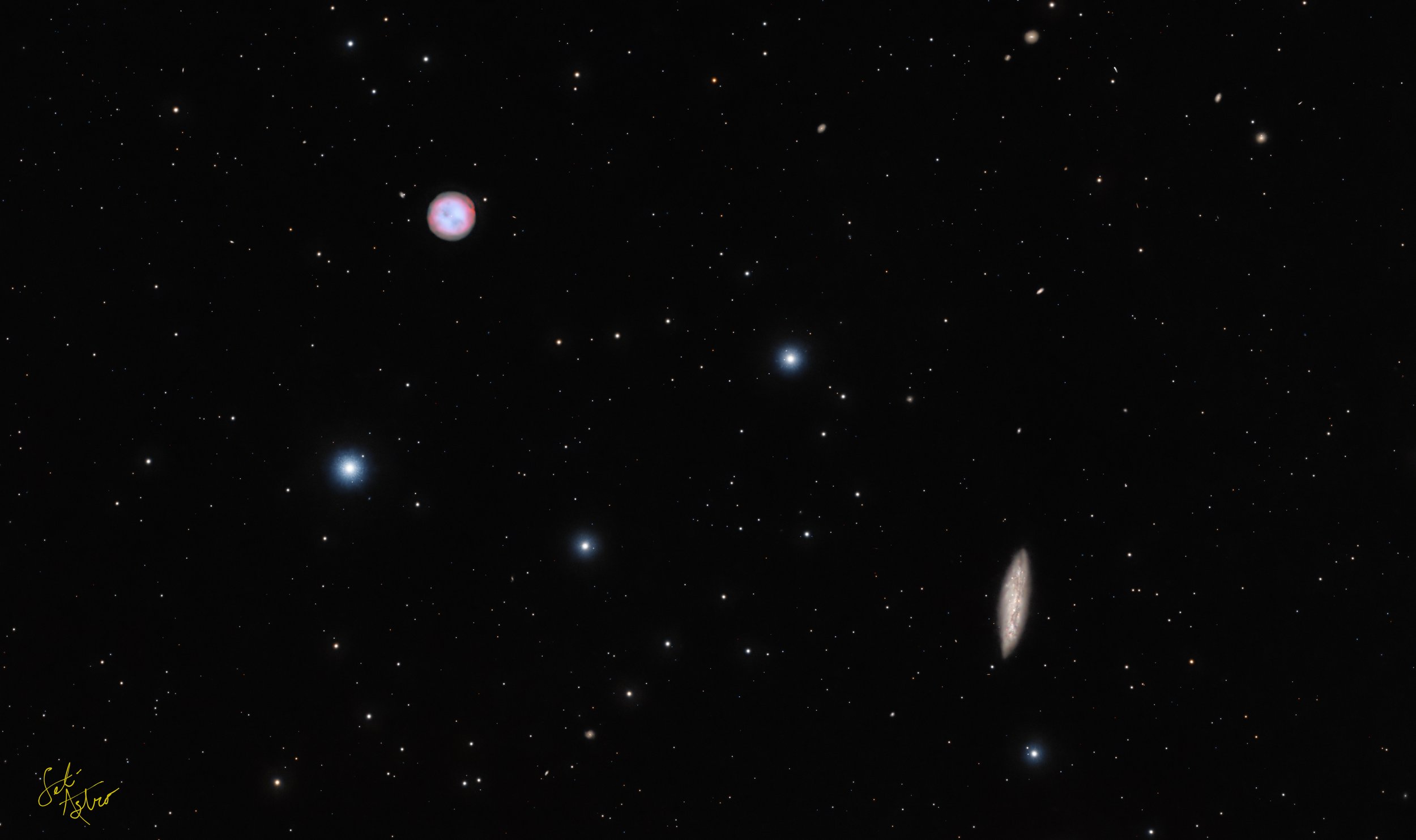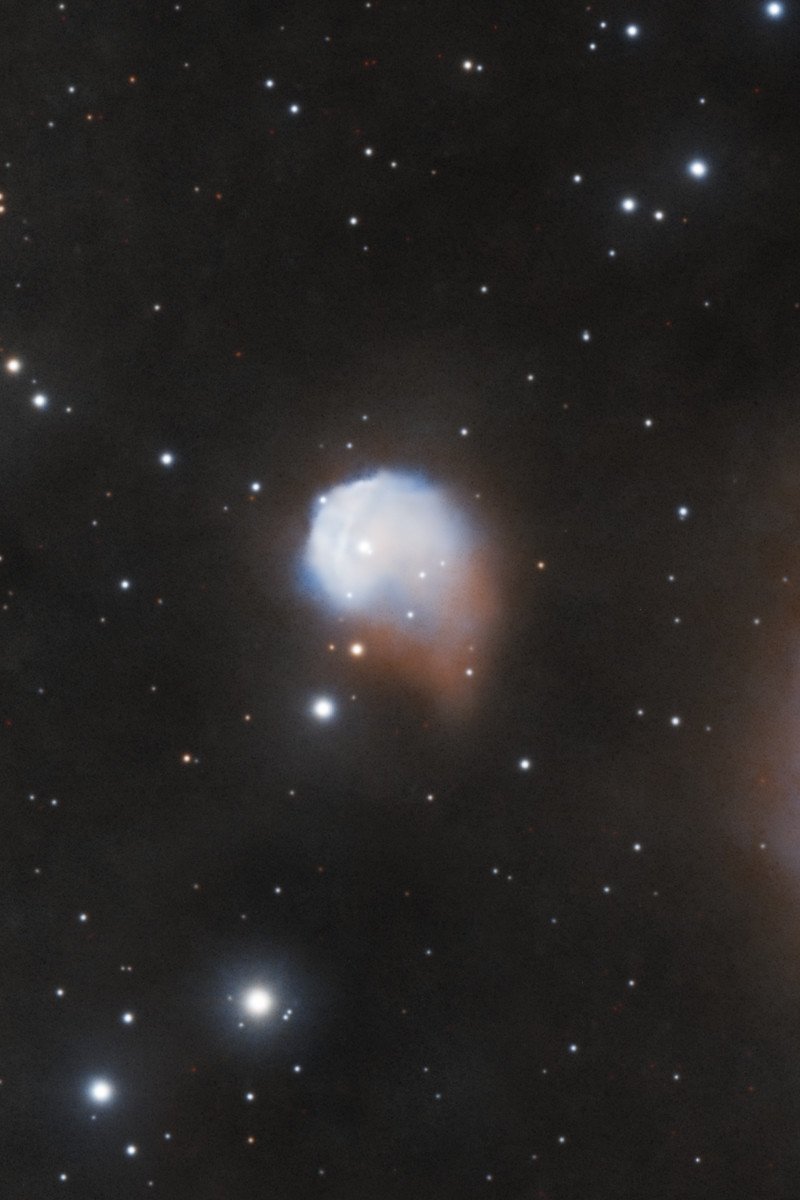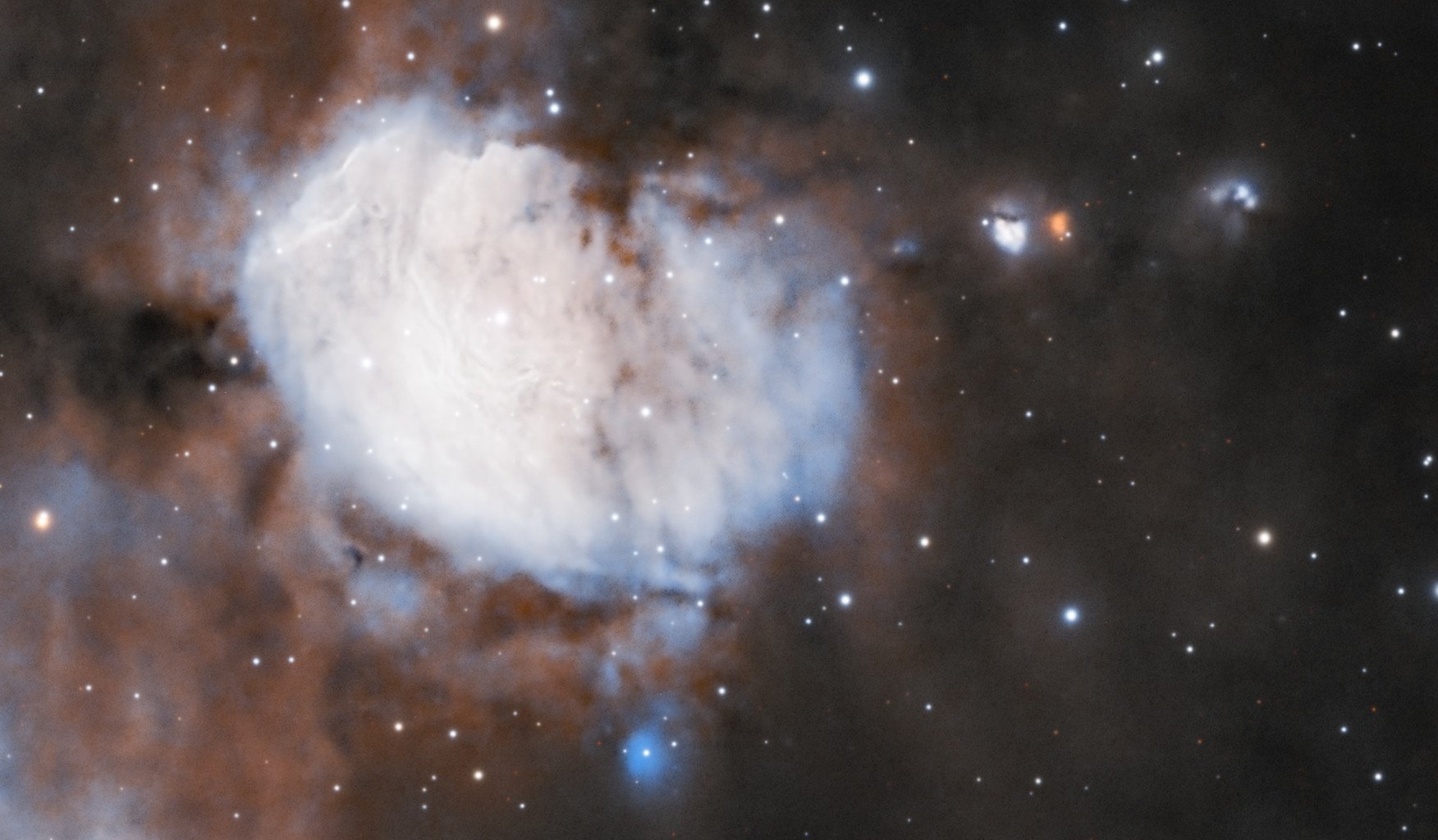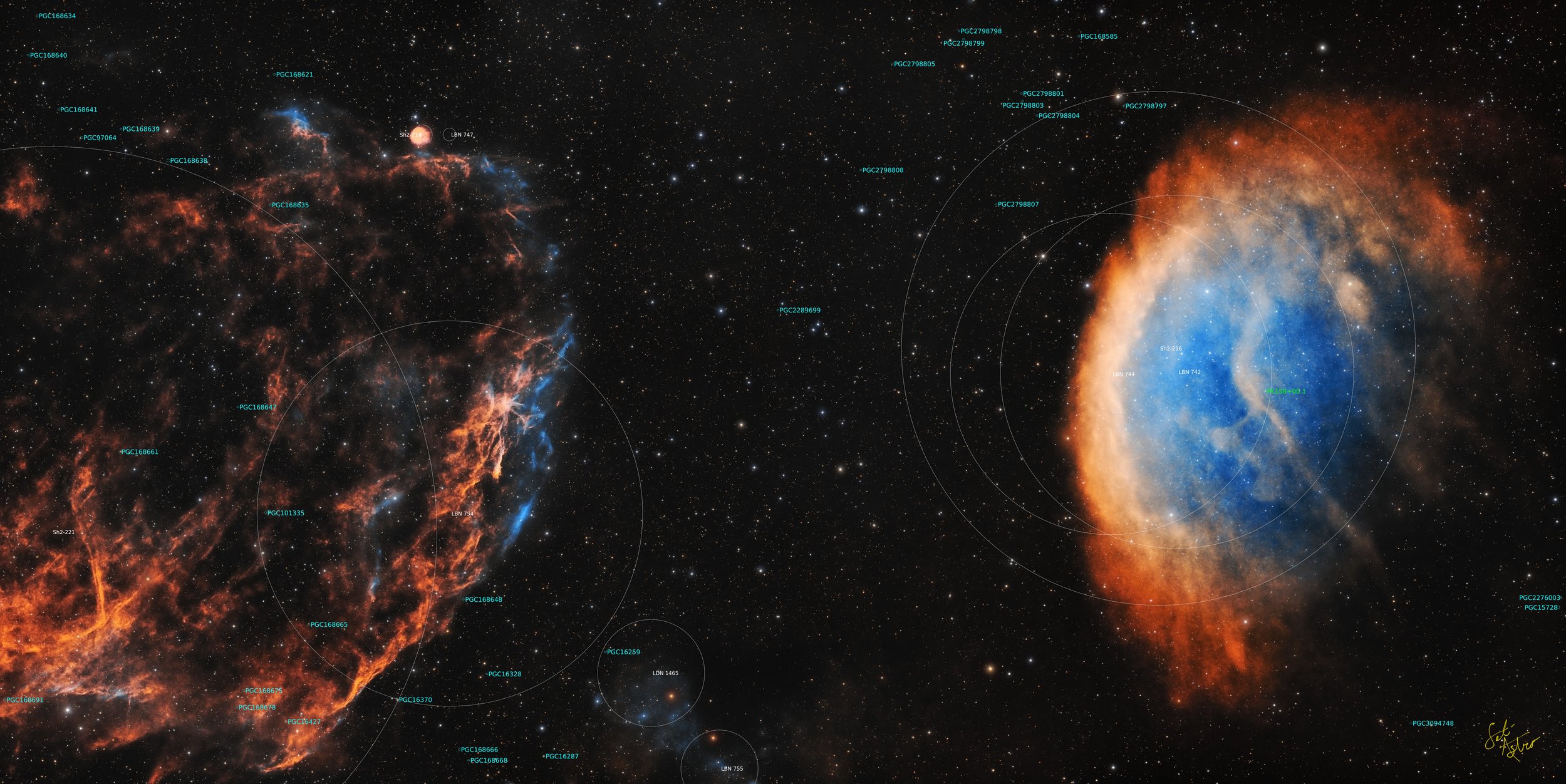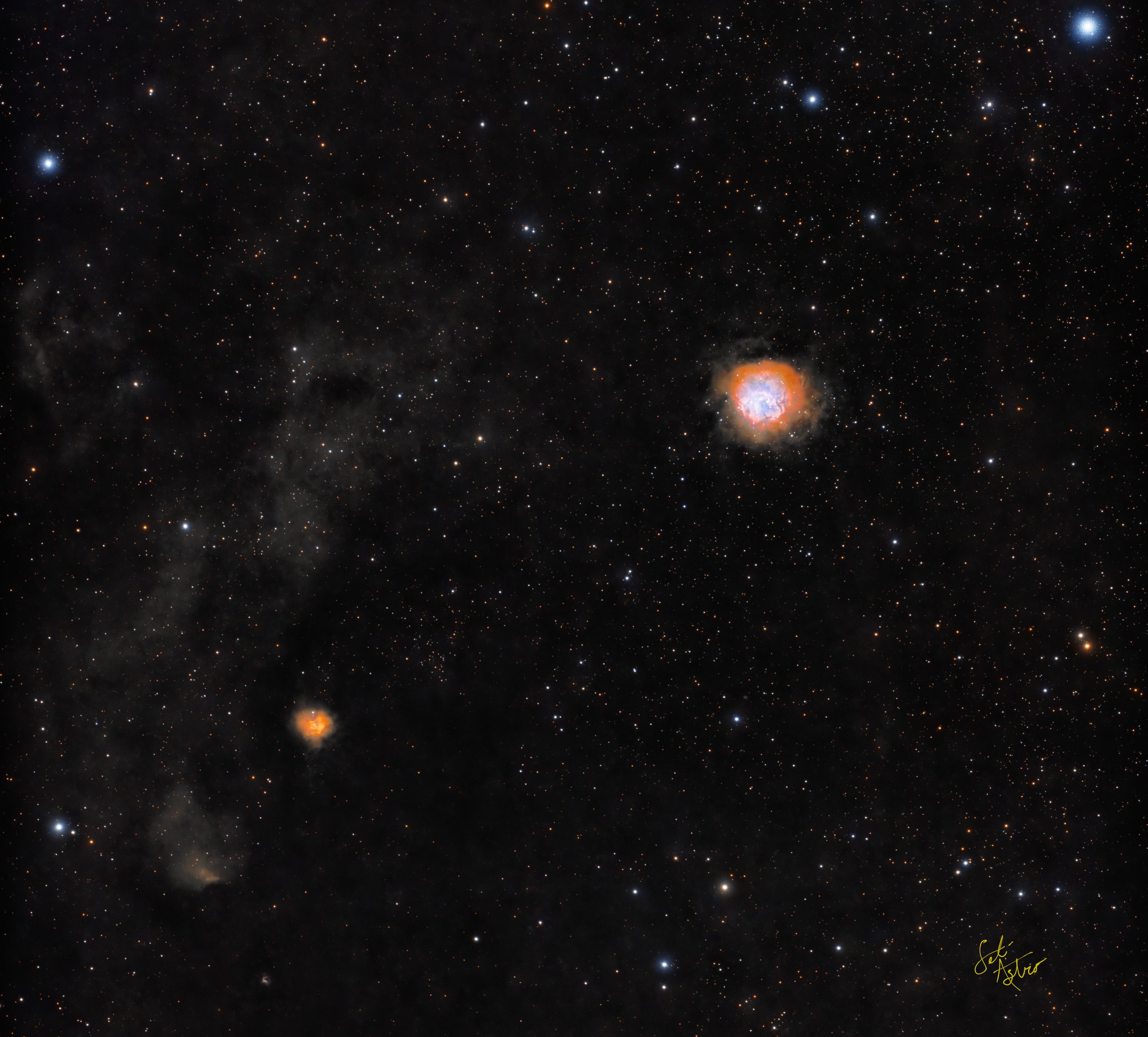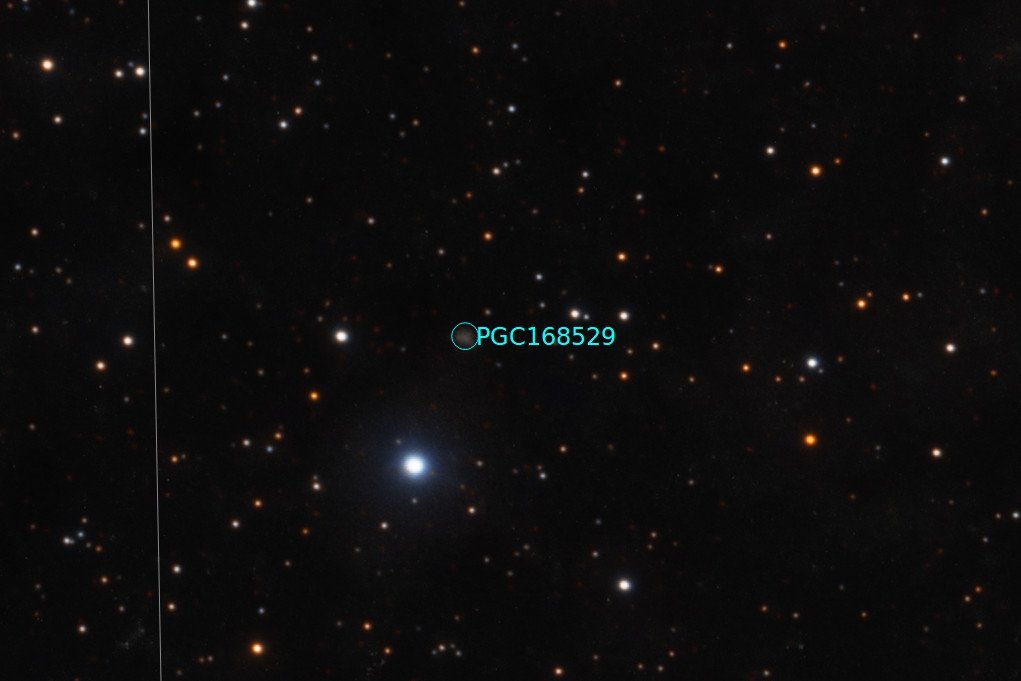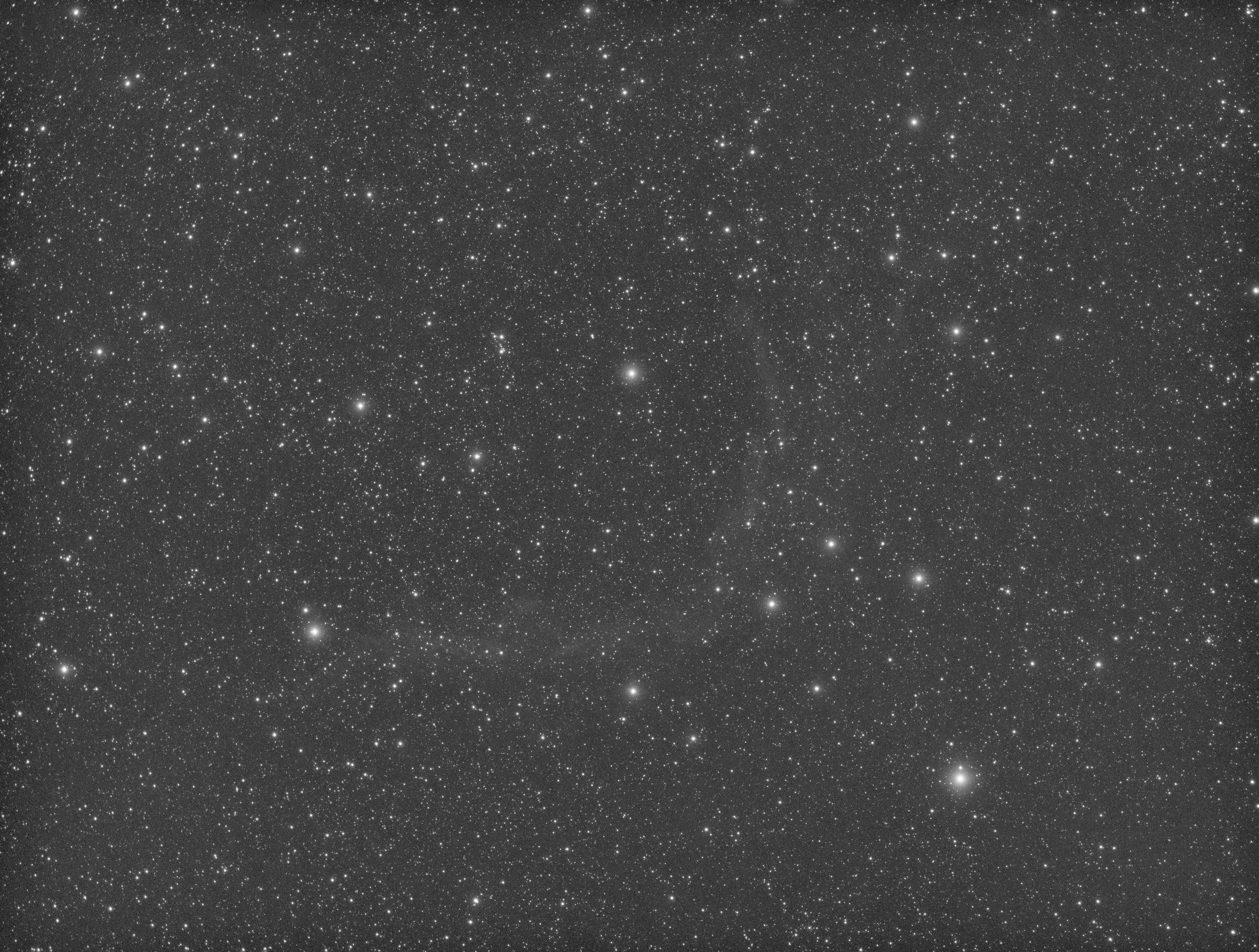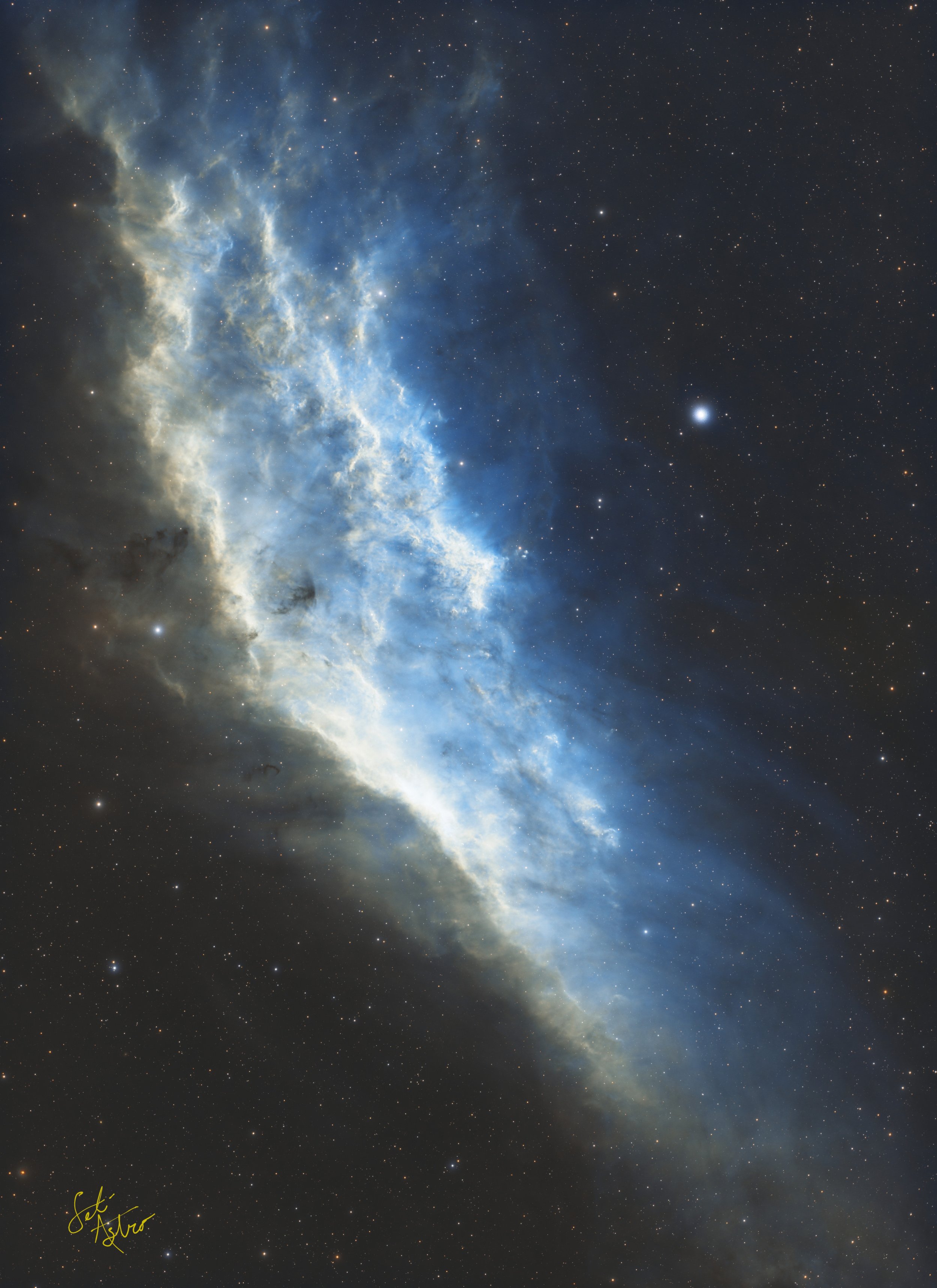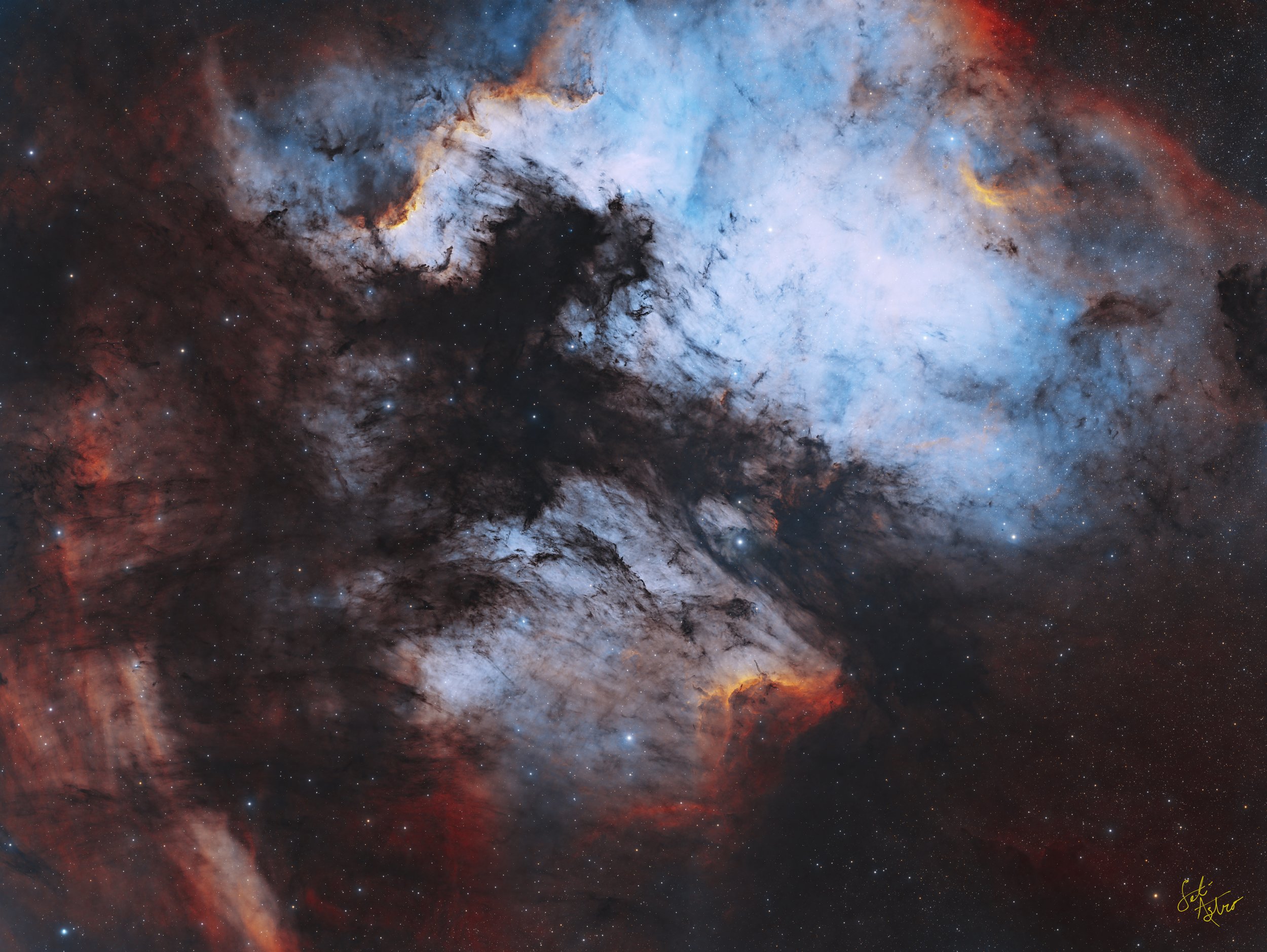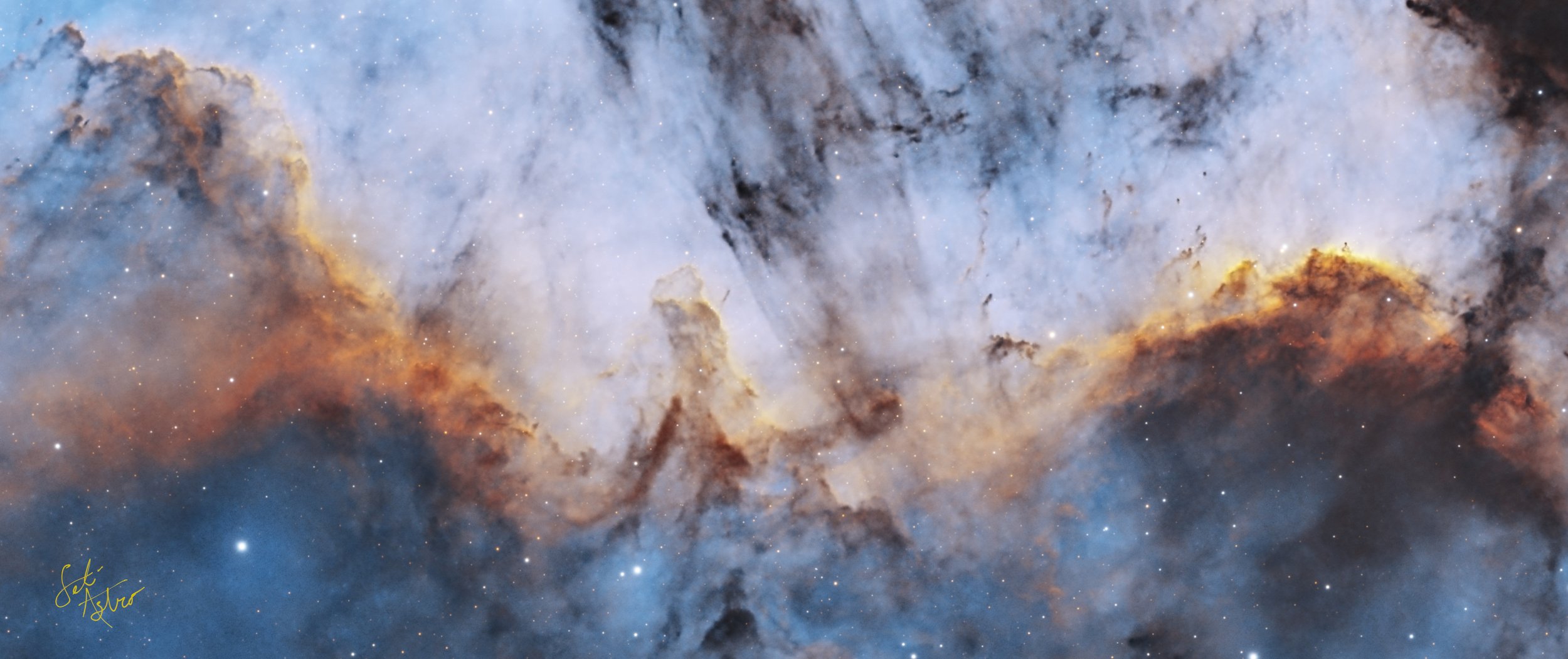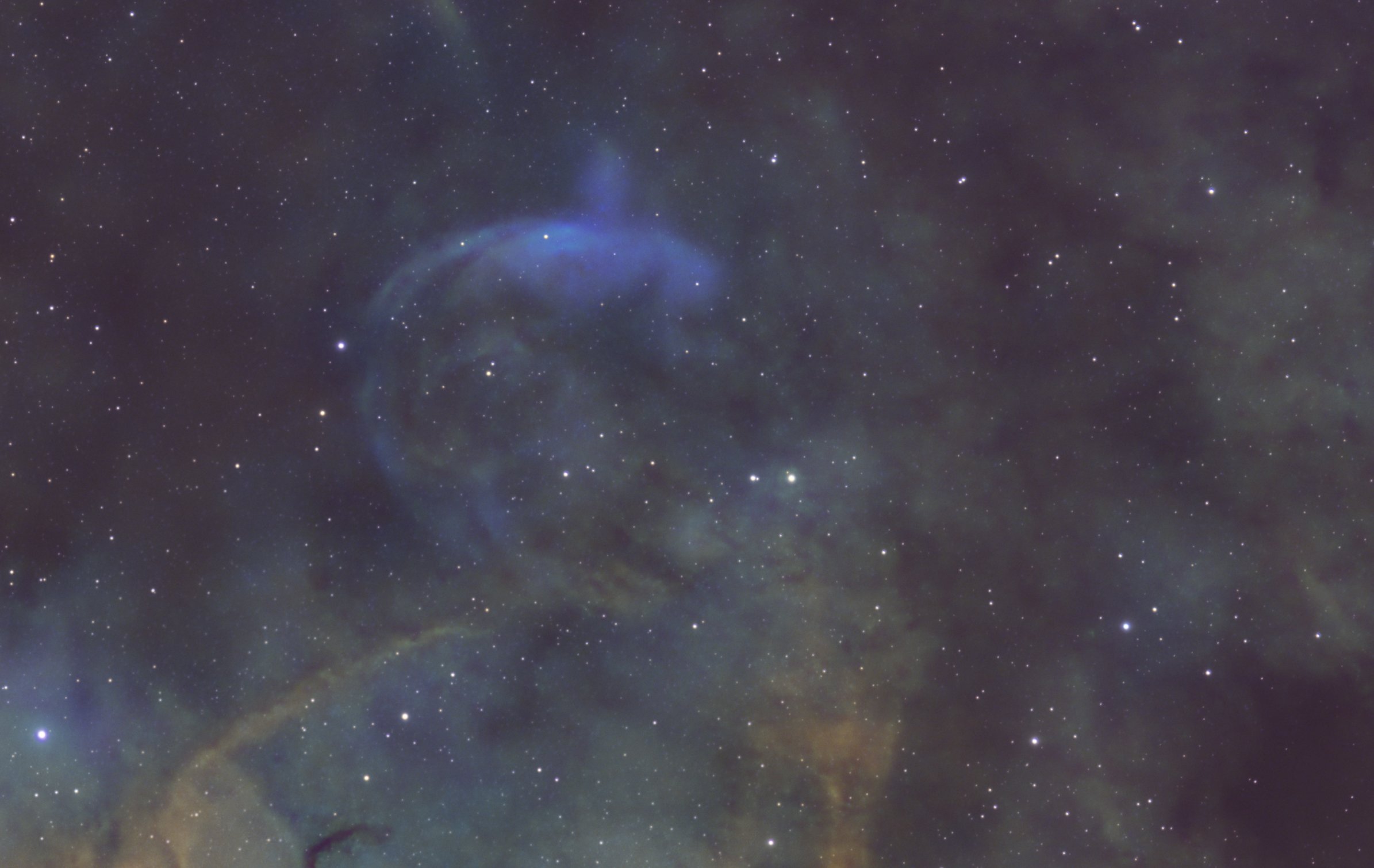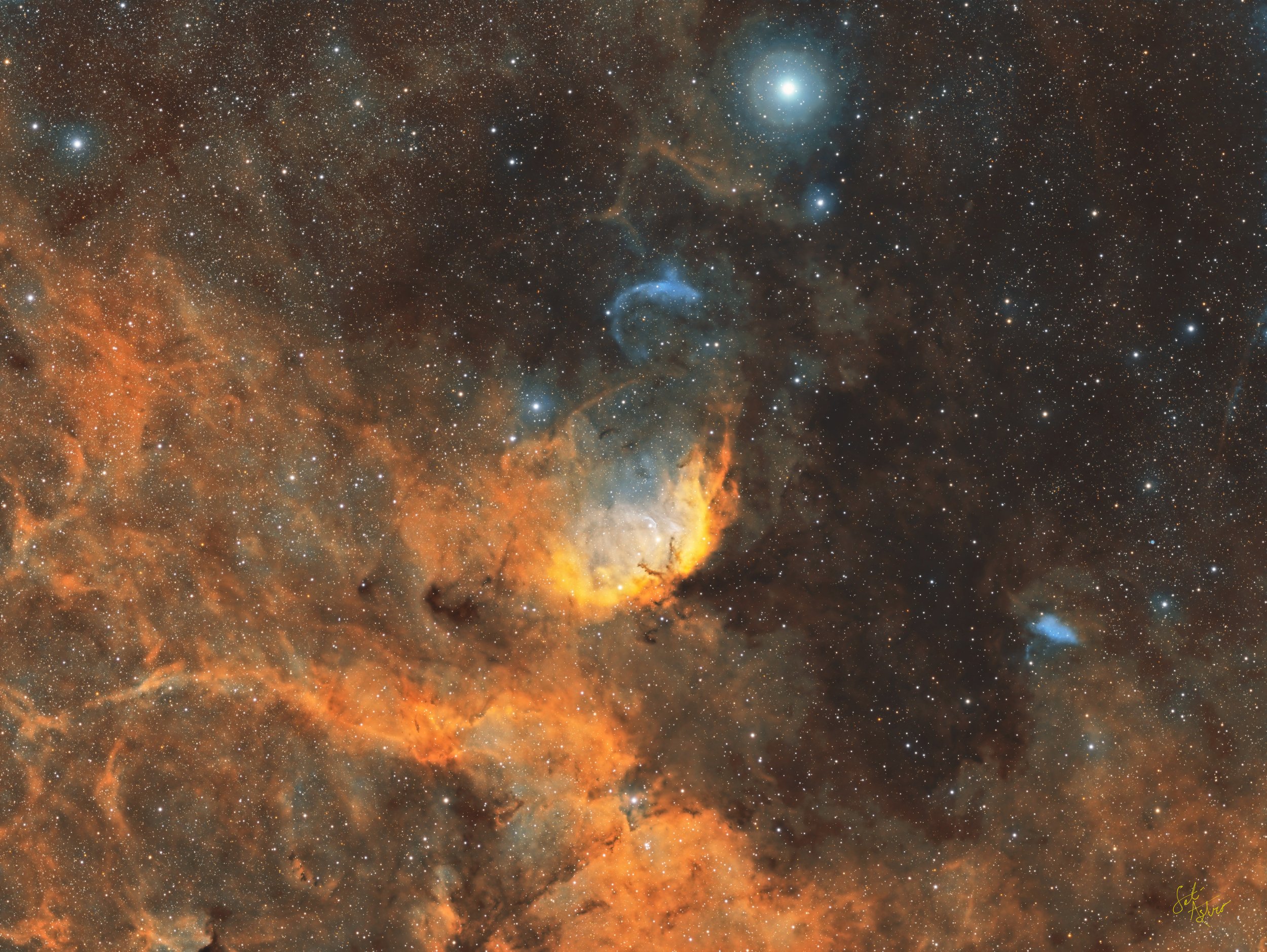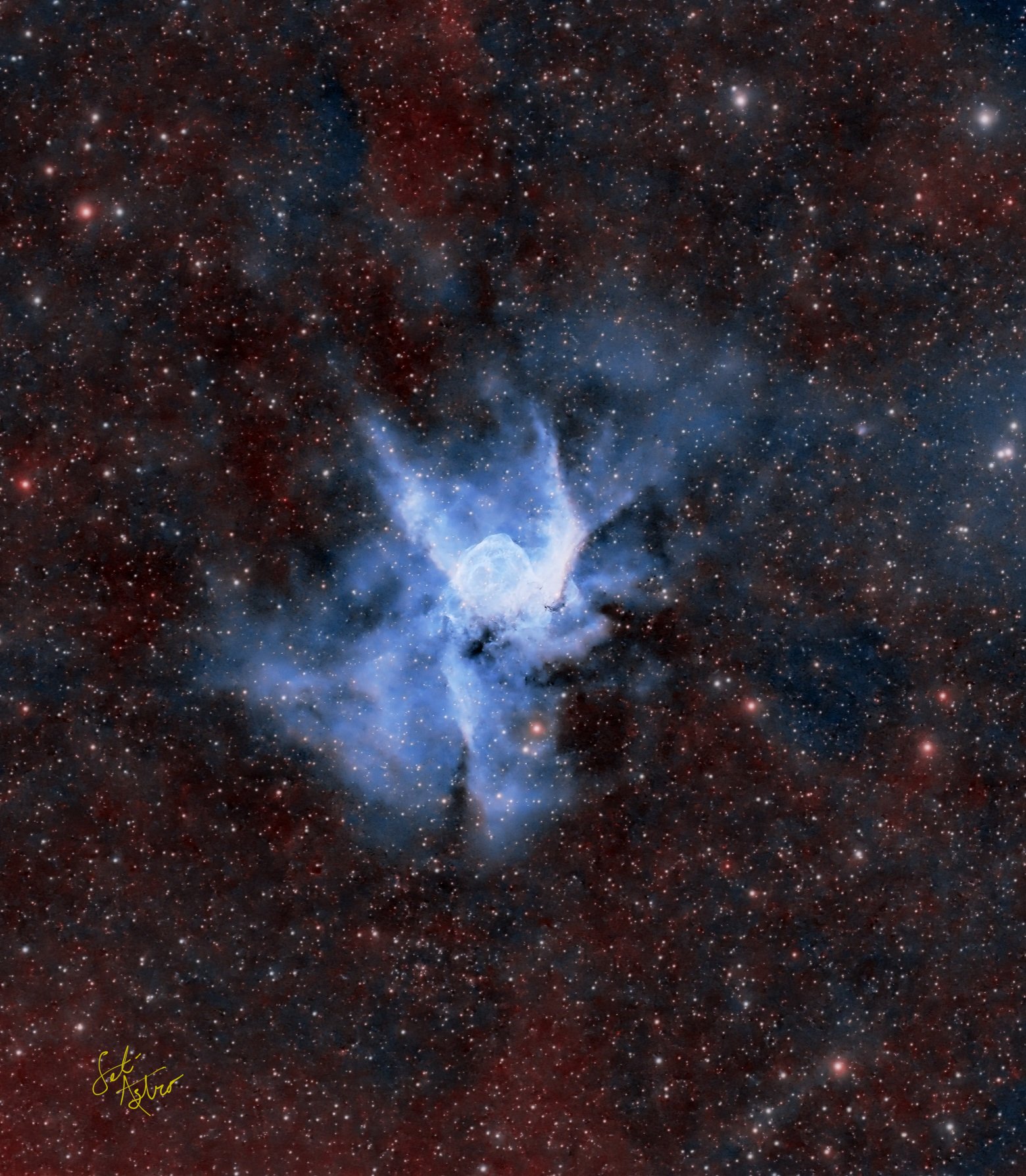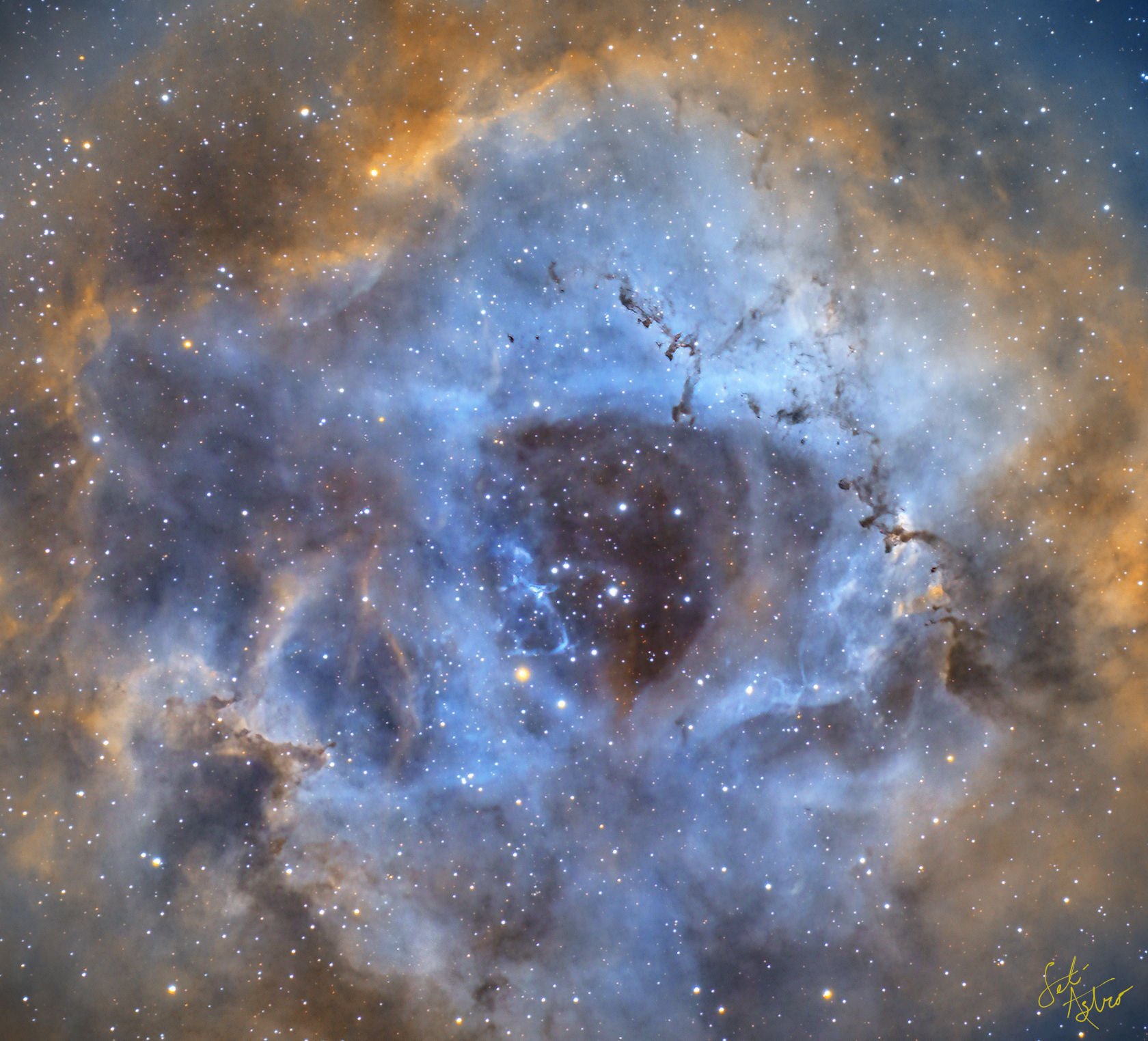A Journey on Horseback: Barnard33 HorseHead Nebula in SHO
This has to be the most imaged nebula out there and not new to me either but what a journey it has been since the very first time I shot this. 11years ago on a homemade wedge sat my Nexstar8se with a modded DSLR and home made peltier cooler.
The crazy accretion disk looking stuff was caused from internal reflections in the inner baffle of the C8. I didnt know what flocking was and had to figure out how to flock the inner baffle tube. So the next season I had a used NEQ6 mount (which is still my mount) and using the C8 now properly flocked I went for the horse again
I was hugely satisfied with this result and let it lay for the next decade.
I think my patience, skills, and equipment have definitely changed with the times as well now over the next 10 years. I wasn't intending on shooting much on the Horsehead since it is so popular but ended up acquiring a good bit of exposure on it. With all things now certain aspects completely surprised me. Most notably is the almost complete lack of OIII. For how bright the horsehead is in Ha there is almost nothing to speak of in OIII. The biggest signal was just that of the blue reflection around the Lump Star HD37903. Although I think this area is beautiful and full of glorious reflections and emissions it is those tiny hidden gems often overlooked deep in the dust.
And a star I just find so intriguing nesstled right up in the HorseHead. B33-13 sitting right in it with a measured parallax of 1.706mas putting it at 1900Lightyears away
Details and Acquisition on Astrobin: https://astrob.in/9wyh3r/0/
Cosmic Portrait in Profile SH2-311
I finally turned my scope around and looked south. This is probably at the very southern extreme of what I can image. Only getting a few really good hours when it finally rose high enough. That didn't stop me from trying the entire time it was over 10degrees. Ended up needing to cull about half the frames though being so low there is a lot of atmosphere between me and space that caused issues.
Usually referred to as the Skull and Crossbones nebula, I was completely struck by how much it looks like a person in profile looking off to the left in this image with a long slender neck of gas and nebula and possibly some sort of headress on. Maybe like one of those old Eqyptian statues.
I absolutely enjoyed trying some other palettes with my Perfect Palette Picker and made a pretty cool SHO-OHS mirror image.
The nebula itself has a lot of interesting structure. 2 different knots of very bright hydrogen and sii and some very large arcs of OIII. Spitzer alone discovered 45 young stellar objects within the area here. Maybe it is because it is so far south in the sky there isn't much listed in any of the catalogues for it. There are two areas Haffner19 and 18 which is home to young open star clusters. Even the bright star HD64315 which gets a lot of credit in this area is the star ionizing the neck structure. All the interesting objects are above it!
Link to Astrobin: https://astrob.in/dt5jof/0/
My video on my image: https://youtu.be/c8nGFlRNlP8
What do you see here? My SHOOHS mirror image. Two people looking at each other? A vase in between? A Rorschach test for sure!
Caught a Lunker: The Fishhead Nebula in the Cosmic Pond NGC896
I never intended to get a lot of data on this target. It was a target I chose to grab a few hours in the early evening before my main targets would rise. Slow but surely I got more and more data on it over many nights. An hour here, couple hours there. Before I knew it I had really gathered a good bit of data on it and went to see what was there. I was not disappointed! The very familiar fish head nebula is now a large lunker of a fish surrounded by cosmic sea weeds and nebula pond life I dont see in other images of this. There are some very amazing dark column structures and huge flows of gas especially around the mostly obscured OIII emission region under the belly of the beast! Another area with amazing dark structure is near the bright star HD14817 at the left edge of the image. In the lower right where was substantially more SII emission leading to a darker red hue in my SHO image.
I didn't realize this area would be so dense with nebulosity across the whole of the image. It is so dense in fact there is only 1 galaxy peaking through. Besides its designation ZOAG G133.96+00.87 there is nothing about it listed. Boy does it look very tiny compared to the breadth of nebulosity everywhere. This is by no means a wide angle image either.
I know most people go for the heart of the heart nebula, Melotte15, but I am glad I decided to get an hour here and there on this one!
Link to Astrobin: https://astrob.in/gtq64h/0/
M78 Casper the Friendly Ghost Nebula
Often overlooked this time of year with the big focus on objects like the horsehead or orion nebula, just off the side of Orion is the Casper the Friendly Ghost nebula M78. A very bright pair of reflection nebulae with dark secrets hidden behind dust lanes. Curious about that I took a decent amount of dedicated Ha data and continuum subtracted it from the red channel. The amount of Ha filling and swirling around the whole image was breathtaking! Also in Ha hidden structures in the dark dust lanes peaked through revealing dozens of Herbig-Haro and Young Stellar Objects! I made two seperate collages showcasing them.
I absolutely struggled on how to merge the Ha with the RGB. There was just sooo much Ha swirling and filling the image it was a balancing act to not wash out the beautiful RGB. In the end I decided to showcase the RGB as the main image with the HaRGB as the mouseover. Please let me know in the comments if you prefer either HaRGB over the standard RGB image and I will gladly swap them.
Below are some close in crops, dedicated images, and collages. Enjoy exploring the image!
Link to Astrobin: https://astrob.in/lom583/0/
NGC2175 The Monkey Head Nebula in HOO+SII
This has been on my list for awhile. Unfortunately I had to toss out almost a full night of images do to high clouds. That said I was amazed at how much surrounding structure in Ha there was for this target! Most of the images I saw prior to shooting this seemed to show NGC2175 pretty isolated in the surrounding blackness. That just isn't the case at all! For the palette, after seeing the initial SHO image, with Ha completely dominating the entire scene I had to pivot what I wanted. Ended up running the great ForaxxPaletteUtility script by PaulymanAstro as well as an HOO+SII blend I did myself. Seeing both had their strengths and weakness I averaged them together to get my final palette (Foraxx had the nice bright blue center and HOO+SII had the great reds around the main bubble of nebula).
There are some really great little things peaking through. SH2-252E is really cool. It looks like it is being ionized by UCAC4 553-022951 -- Eclipsing Binary but there are infact a lot of young stellar objects within there. It is a true star forming region unto itself!
Another really weird structure is just listed as WISEA J060825.57+210456.8 Infrared Source, but it does not look like anything i've seen and it is very faint on the IRSA finder charts as well. It is really small, just 12"x7" at its biggest. So if anyone has a big scope on a mountain they want to take an image of I'd be excited to see it 06h08m25.5706s, +21d04m56.889s
One other intriguing area are the giant loops of Ha getting blown to the right in the image (north) of the entire structure which seem not commonly seen in images of this particular target along with a shock front above (east) the main structure.
Link to Astrobin: https://astrob.in/x2kvrh/0/
What Fortunes Do You See in the Crystal Ball Nebula (NGC1514)
LEDA1905882
WISEA J040802.77+301508.8
WISEA J041036.53+301728.5
WISE J040858.78+311431.4
What a great little planetary nebula (and it is pretty small. 2arcmin in diameter for the bright inner part and 3arcmin in diameter for the outer halo)! It sits just 1500 lightyears away. It was this object that made Herschel rethink a lot of what he though the heavens were comprised of. I took a full set of LRGB images as well as dedicated OIII and Ha images to give as much detail into this little PN as I could.
Not only is the PN itself just a gem, there are so many interacting galaxies in the background which would easily fit into the Atlas of Peculiar Galaxies. One very intriguing one to me is one with an interacting double lobed structure (LEDA 1905882). The WISE J04085.78+311431.4 with pinwheel or octopus arms is sitting at a staggering 685 million light years away. It truly must be quite massive to have so much detail resolved on it. Looking through the NED database and IRSA finder charts I may have some of the best resolution of these galaxies in an image.
There is also dust reflecting off bright magnitude 8 star HD26125 that is designated Ced28 Interstellar Medium.
This is a slightly cropped in version (for better framing) of the full version which is available for viewing in this revision.
Link to Astrobin for more info: https://astrob.in/p2m8m3/0/
Raging Fire in the Flaming Star Nebula
I have not imaged the Flaming Star Nebula and finally decided to put the scope that direction. What a surprise I had when SII seemed even stronger than Ha and OIII was almost nonexistent. The SII (not surpising) was more detailed, but the surprise to me was the extend of it. Filling the frame even more than the Ha. The OIII I believe is mostly not OIII but part of the reflection nebula around V* AE Aur. There are only 2 visible galaxies peaking through and just barely, the entire image is just emission nebula. Orientated this way it really reminds me of a raging forest fire. You can almost see the movemetn of the flames reach up and getting blue hot up towards V* AE Aur.
Link to Astrobin : https://astrob.in/vbrl2x/0/
SH2-206 Fossil Footprint Nebula
For an object with a very bright central portion I am surprised this isn't imaged more! There was lots of detail even in the OIII and SII filters. Since there was so much hydrogen filling the entire frame a traditional SHO palette would have been difficult to tone the green down. I decided to go with the HOO+SII palette that Adam Block recently put a video out on, although he was not the first to do it as even in Jurgen's Toolbox the NB Combination tool defaults to that palette, I figured this may be a good target to use that approach on anyways. There are a number of very massive stars in the central region that really is driving the emission of everything with their strong UV light. OIII is the hardest to ionize and really is mostly centralized around that cluster near the core. A number of very dark dust lanes are through out the image too giving it some really nice contrast
Link to Astrobin: https://astrob.in/97tibe/0/
NGC1333 A Dusty Embryo
What an intriguing object!! In the middle of a very broad dust cloud there is this gem featuring reflection nebula, new star forming regions, dark nebulosity, outflows, and the most Herbig-Haro objects I have ever seen in one of my images. This is also the deepest in RGB I have ever gone on a target as I normally shoot almost entirely narrowband but wanted to try something different. I did collect a decent amount of Ha data that I continuum subtracted and added into the Red channel to really highlight those HII regions of stellar birth. Another big surprise to me was that the entire frame was full of dust nebulosity, the field is so dense that there are only 3 galaxies in the background peeking through at all! Below I have compiled some collages of some various objects and there is even one visible MASER. Not sure why it is called the embryo nebula, but the dozens of Young Stellar Objects and Herbig-Haro objects confirm there is new stellar life forming in there!!
Link to the video on this image: https://youtu.be/3MT81fVIF0I
Link to Astrobin: https://astrob.in/bloqft/0/
Everyone likes doing the heart of the heart nebula. Well I want to peer into the soul! Just some amazing objects to be found in here. The region I find especially beautiful is the figure I'm calling the Mountaineer climbing up Spirit Mountain within the Soul Nebula. Under the roots of that mountain is an HII emission region just streaming off both Ha and SII and being fueled by a chemically peculiar star. In the great OIII bubbles of the soul you can find some amazing examples of globules both dark and ones reflecting the surrounding stellar light, and one object you this is a globule but is actually a galaxy! There is even a portion where it looks like the fingers are casting shadows on a hillside. What objects do you see?
Link to AStrobin: https://astrob.in/m0sd16/0/
Peer Into the Soul Nebula (LBN673)
Gone Shrimpin’ (SH2-188 The Shrimp Nebula)
SH2-188 is really showing off what my imaging newt can do! Not only does it easily show the full main circle of the planetary nebula but there is a much larger and fainter outer bubble in hydrogen and much fainter in SII. Commonly called the Shrimp nebula is very fitting from where I am imaging down near the bayous of Louisiana where shrimpin boats come in and out of daily!
So it does appear there is a double bubble of expanding gasses and ionization from the central star. The southeast limb is very bright and I had to employ some HDR tactics not to blow it out as the expanding gasses are colliding with the interstellar medium exciting OIII in that region. There is also a faint whisp of hydrogen extending down to the east of the planetary nebula that I do not believe is associated with it at all.
Beyond the main object in the frame the rest is very devoid of much in the catalogs. There are no quasars at all and only 2 other visible galaxies in the Simbad catalog. There are a number of tiny non-stellar pointlike sources in the starless image that do show up in the Vizier and NED catalogs as various 2MASS objects.
Link to AStrobin: https://astrob.in/gzuwy2/0/
Video I made on this Image: https://youtu.be/sdd9rXyZO2E
The Wizard Nebula: Orton casts a glow spell
With a very well imaged object such as the Wizard nebula I wanted to present it in a slightly different light. This rotation angle makes it look much more like the Tulip nebula than the classic orientation of the wizard. I also did a blend of a traditional SHO process blended with the output from the Foraxx Palette Utility. Then utilized the very brand new beta from PaulymanAstro ( @Paul Hancock ) and his Orton Glow script.
There are some amazing structures that stand out when it is orientated like this. The dark loops that appear to be following gigantic magnetic field lines reminiscent of the superconducting structures in the movie Avatar
There is also the truly dark nebula off to the left in this image TGU H665 (bottom part of LDN1200) so dark it is blocking out almost all the stars behind it.
I also explored this area in my What's In My Image script and saw Spitzer had imaged the dark nebula. So I pulled down the 736 images, used MosaicbyCoordinates and GradientMergeMosaic. It covered just a strip through it. There is so much data that Spitzer collects, the professional space can really provide a wealth of data to dig into!!
There is also the little known and little catalogued WISE G107.209-01.334. I haven't seen many images with the detailed structure in it like this
There is also some OIII bubble like structure around the star HD215806. I see there is an IR nebula listed but nothing for the OIII structure. It is best viewed in the starless version
Lastly in this orientation the outer wall of the where the intense UV drops off and excitation transitions to the Ha and SII is very nicely framed
More data on AStrobin: https://astrob.in/euj82a/0/
SH2-126 The Cosmic Gecko
This turned out to be a lot more challenging than I thought it would be when I first started. The reflection nebula is very dim and the star field is very dense. Took a lot to tease it out from the background! In the end it is just an amazing object! The gecko wrapping itself around the hydrogen column. There is such a difference in the RGB data vs the hydrogen, really leads to a lot of contrast in the image. I continuum subtracted the Ha channel to really allow a nice pure addition back into the RGB.
There are a number of really amazing objects within the field of view as well. Right in the head of the gecko there is a "X" shaped object that is Emission Line Star LkHA233 with Herbig-Haro Object HH398 all inside reflection nebula GN 22.32.5
There is also are very neat column object right in the tail. An Active Galactic nucleus candidate UGC 12086, and plenty others like WISEA J2231214.96+395809.8. I spent a long time just exploring around the image with my What's In My Image Script. So much of it required using the deep search since it wasnt in the SIMBAD catalog.
My video on this object: https://youtu.be/XRJyiZo6gqI
More details on Astrobin: https://astrob.in/pj0seb/0/
Southern Part of G65.3+5.7: The Other Witch's Broom 2-Panel Mosaic
Very faint supernova remnant in Cygnus. Designated SH2-91 or G65.3+5.7 it is a very large complex. I decided to go for a two panel HOO mosaic. I had a grand total of just over 52hours between the two panes and filters. There was some additional time to try and capture detail close in on Campbell's Hydrogen star. An amazing object by itself. While working on the first pane and exploring the image I found an amazing little gem of a planetary nebula. Technically it is a PN candidate, but looking at the image there is no doubt it is a PN. Campbell's hydrogen stars is an interesting item right in the middle of the field of view too. When originally looking around the image I thought for sure that was a carbon star, but pulling up my What's In My Image script it quickly identified it as a planetary nebula too! It is actually an object Hubble imaged, so I took a series of 30sec exposures to not blow out the core and see if I can see anything in there. Sure enough it appears as a bull's eye. A bright star surrounded by a bubble of hydrogen. I have a comparison with what Hubble saw, needles to say my set up is not Hubble It is only 4 arcsec across so I wasnt expecting much, but rotated to match hubble has similar asymmetry!
Link to Astrobin: https://astrob.in/vh30cc/0/
Link to my video on it: https://youtu.be/bkuN92Pqq8Q
WR-134 When the Universe Stares Back at You
52 hours of exposure!!
This one was on my bucket list. The more OIII data I gathered the more structure kept coming out in the Eye. Just an amazing object with some hidden gems. I tried my best to preserve all the different structure in each channel. It was somewhat difficult as all 3 Ha, OIII, and SII really had different defining structure!
The main eye structure is the upper bow shock and OIII emissions that are being stimulated from the intense UV and wind from WR-134 in the center. Below the main eye though there is another bow shock in SII which I find very peculiar!! Hidden in the eye is a planetary nebula candidate and the entire regions has lots of reflection nebula (some of which don't seem to be listed) and tadpoles.
Astrobin link for more science and details!: https://astrob.in/h3r63k/0/
M16 The Eagle in Foraxx
First attempt in 2013
Kicking off nebula season with the very famous M16 Eagle Nebula. This is an object I originally imaged over a decade ago when I first got my Nexstar C8 with a DSLR and never really went back to do it justice. After chasing very dim nebula I was shocked at the high dynamic range this actually presented. I'm presenting mine in a Foraxx palette. I utilized my NB to RGB star script for the stars and did my initial channel stretching with my Statistical Stretch script. There are some really less known tiny objects around the field of view as well. Multiple Planetary Nebula / Emission Objects. A relatively bright Emission Line Star with the gas cloud interacting with it. Many dark fingers of dark dust columns where new stars are getting born as well.
Link to my video on this image: https://youtu.be/Oanv1yMHrhA
Link to Astrobin: https://astrob.in/w2ox0v/0/
SH2-313 Abell 35 A Bow Wake and a Flaming Crown Nebula
This is a very dim nebula in Hydra and was a challenge to shoot. Even at transit it is only 35degrees in the sky, decently small (10' across), dim(26.2mag/arcsec^2) and I have my neighbors roof to contend with.
What an intriguing object it is though! There is some debate on whether it is a planetary nebula or a Stromgren sphere . The central star is a binary pair of white dwarfs in a very tight orbit. This is one of the rare times you can see the motion of the stars through the medium. Especially in OIII you can see the wake it is forming as it is moving through the center part of the nebula. As with all debated objects in astronomy there is tension on whether it is proper motion of the binary pair through the central gasses or the gasses moving past the binary pair and interacting with the strong magnetic fields the white dwarfs are creating. Either way the visible motion is just amazing and something rarely seen. We are also graced with a plethora of galaxies and even a Carbon Star in the frame.
Link to Astrobin: https://astrob.in/tmkjum/0/
From Centaurus to Carina Mosaic in Ha
Just an amazing capture in the Southern Hemisphere. Most of us in the Northern Hemisphere never get a chance to see these gorgeous objects. I got permission from a fellow citizen scientist, Gary Liney, to showcase his mosaic on my site. One day I want to get down under and image the Statue of Liberty nebula myself (the central nebula in this mosaic).
Again, much thanks to Gary. He has an amazing site showcasing his efforts to shoot the night sky. Highly recommend his website: http://www.austrophotography.com/
Abell 31 The Moon Jelly Nebula
Abell 31 (SH2-290), what I am calling The Moon Jelly Nebula, is a very dim Planetary Nebula in Cancer.
Even with 32hrs of integration time it was a lot of effort to pull it out nicely from the background. Ha was the strongest, and the core full of OIII was well visible. SII on the other hand was almost nonexistent! Abell31 is described as "ancient" but didn't find more on the age and lies around 2000 lightyears away. It being so old is why it is sooo dim as all the gases are dispersing and very far from the central white dwarf now greatly reducing the gasses ionization.
In the surrounding starfield there is a handful galaxies and a lot of the discovered by GAIA and are very dim and faint. There is no distance data to any of the GAIA galaxies I could find either. The other interesting item is a very close double star HD76037A&B, they are just shy of 300 lightyears away and only 9 arcsec apart. Although I couldn't find if they are true binaries or not, their parallax would suggest they probably are: 10.9939 and 11.0133 milli-arcsecs which is 296.01lyrs and 296.5lyrs away.
Link to Astrobin: https://astrob.in/8ktleh/0/
NGC 2346 The Butterfly Nebula - A Dance of Two Stars
NGC2346 in Foraxx HOO palette.
Not a whole lot of amateur images of this one. It is quit small and had to push drizzling and plenty of strong dithering to bring out as much detail as I could. Effective f/ ratio of f/12 at this resolution on my 120ST.
I did take deep long exposures of the broader area and there really isn't much at all surrounding this nebula. I did an annotated zoomed out version even highlighting various types of stars and galaxies and only 2 galaxies and a handful of variable, red branch, and carbon stars. Really nothing else!
The other thing I find just absolutely surprising is this was created by a dance of two stars. They orbit so tightly their period is only 16days and is only split by spectroscopy. When one went into a red giant phase the other star just plowed through the outer layers of it shredding it apart and flinging it into these two lobes you see.
Link to astrobin: https://astrob.in/2f779j/0/
SH2-284 The Portal Nebula
SH2-284 The Portal
Lots of gorgeous structure with beautiful blue from OIII making a nice backdrop for various columns and dust lanes. There are a number of unusual objects surrounding the area as well. In my annotated version I highlighted Carbon stars, Peculiar Stars, Bubbles, and HII regions. There is also a very strong SII red area directly below Bubble E79 that does not show up on any Simbad catalog and since it is most strongly in SII it may be a new structure! There is also NGC2282 with its unusual dart structure that is unnamed as well. The main bulb of SH2-284 is ionized by the bright young stars that form the cluster Dolidze 25.
Link to Astrobin: https://astrob.in/hkgw4u/0/
Link to my video on this image: https://youtu.be/boLzcUQv7l0
Jones-Emberson1 The Headphone Nebula
A very north planetary nebula Jones Emberson 1 or the Headphone Nebula.It lies about 1600 lightyears away. The central star is a blue white dwarf. Although it is a fairly faint nebula for imaging it had relatively strong signal. What really interested me are a lot of the surrounding galaxies. You can see amazing color and spirals. There is even a galaxy with an active galactic nuclear near NGC 2474 and 2475 that shows red structure which may be similar to the starburst of the Cigar Galaxy or from the active nucleus!
Link to Astrobin for full resolution: https://astrob.in/6l4dxv/0/
The Owl Nebula and the Surfboard Galaxy (M97 and M108)
This was one of the first objects I imaged and decided it would be worth a revisit after almost a decade. I used a Ha enhanced Red channel and a OIII enhanced Blue channel. Along with M97 the Owl there is M108 the Surfboard galaxy and there are some nice hydrogen pockets that show up red in the galaxy. Along with those prominent items there are a lot of background galaxies, some elliptical, some spiral, some forming nice chains! I find the science of the Owl Nebula really amazing. It is 2000 lightyears away and is 8000 years old. The amazing item is the central star, which is now a condensing into a white dwarf, has a surface temperature of 123,000K!
Link to Astrobin https://astrob.in/1327o3/0/
The Eye of Ra SH2-261 Lower’s Nebula
Makes you wonder if the ancient Egyptians were doing astrophotography as this object resembles the Eye of Ra!
More commonly known as Lower's Nebula or SH2-261. It is a gorgeous nebula with a central lake of blue OIII and an interesting shoreline of pillars that the SII really adds a lot of detail to. There is also a very dim region of Ha above the main nebula with a very faint defined cloud. I also was not able to find much information on the central OIII structure that makes a couple expanding bubble regions in the core of the nebula either (I added a close in of just the OIII core). There just doesn't seem to be a lot of study on this particular object in the literature. There is even disagreement as to its distance, but the nearest estimate is over 1000 parsecs.
Links to Astrobin: https://astrob.in/wyeje6/0/
Link to my video on The Eye of Ra: https://youtu.be/GNswqmBo3eg
SH2-232 Pumpkin Nebula and Friends
A lot of items in this grouping of Sharpless Objects. Ha and SII were very strong but OIII was almost non existent with the exception of the planetary nebula PN G173.5+03.2 and a little in SH2-235. For the main image palette I used a SII, Ha, SII+OIII (SH[S+O]) palette and the blue "winter" palette was Ha SII SII+OIII (HS[S+O]).
I do believe there is a non-cataloged reflection nebula just below SH2-235, ALADIN and Vizier show a couple point IR sources but no listing for the nebula itself, if anyone knows where it is listed I would be very much appreciated!!
Link to Astrobin for more description: https://astrob.in/ckq2o0/0/
Link to the video I made on the images: https://youtu.be/YbnZ7XwGUHY
Spider Nebula Caught More than the Fly Nebula (IC417 NGC1931)
The is a beautiful Ha region with little OIII except in the cores of the bright nebula and a couple very curious locations.
While processing I noticed a small "line" nebula and that started me down the rabbit hole to explore this image more carefully.
That line nebula turns out to be the cosmic jet from a new born star! Herbig-Haro Object 190!! In the neighborhood of it there are a lot of Young Stellar Objects (proto-stars and pre-main sequence stars), just babies!
Turning my attention to another OIII rich blob on the right of the image. Aladin and Vizier list it as an HII region (WISE G174.384-00.371). This object does not emit much in Hydrogen at all and was very bright in OIII. Potentially a mis-categorized PN??
But just below that blue blob there is a OII streak going down and to the left. That nebula is not listed anywhere I could find. If someone knows how to get an object confirmed that would be amazing and I could use the help. For now it seems like a OIII streak leading away from WISE G174.
In that same area is a nice reflection nebula, an eclipsing binary, as well as an Emission Line star!
Astrobin details: https://astrob.in/2aq5ok/0/
Link to my video: https://youtu.be/Vw8mrPY_6KI
SH2-224 The Rice Hat Nebula
SH2-224 The Rice Hat Nebula
At an estimated 14,700 lightyears away this is a very faint super nova remnant in Auriga. It is thought that the supernova formed the main bulb which then drifted into an area of low pressure gasses causing a secondary bow shock and cone of ionized gases creating the "hat".
There are a couple very distant galaxies in the image as well, some around 300 million lightyears away and one at the top of the main bulb that is over 700million light years away!!
Link to my youtube video on the image: YouTube Link
Additional data on Astrobin: https://astrob.in/qnix4l/0/
Dual Cosmic Death SH2-221 & SH2-216
SH2-221 is a large dim supernova remnant contrasting SH2-216 which is one of the largest, oldest, and closest planetary nebula known. These two represent 2 different stellar end of life scenarios. SH2-221 lies about 2600 lightyears away and is almost 2degrees across. There is a small bright nebula (SH2-219) sitting on SH2-221 which is a very young nebula, possibly only 100,000 years old, getting ionized by a bright B0 V star at the center. SH2-216 lies only 400 lightyears away from us and is very dim and diffuse due to its age. It is estimated that it is 500,000 years old, and is still faintly ionized by the central white dwarf ALS 8032. There are a couple dark nebula in between the 2 stellar corpses adding to the ghostly darkness.
Astrobin link: https://astrob.in/hgxnbt/0/
Trouble with Tribbles (SH2-211 & SH2-212)
"Spock: "Most curious creature, Captain. Its trilling seems to have a tranquilizing effect on the human nervous system."" - Star Trek "Trouble with Tribbles"
SHO Hubble palette of SH2-211 and SH2-212 (NGC 1624) The Tribble Nebula. All 3 channels had great signal with SII have a ton of little detail in the core of SH2-212. SH2-212 is ~20,000 lightyears away and latest estimates put it very young at only 4 million years old, SH2-211 is embedded in the same CO cloud and puts it around the same distance and age. In the image there are also beautiful dark and light dust lanes and a handful of galaxies. A couple of the galaxies are very interesting to me for their sheer distance from us.
PGC168529 (aka WISEA J044026.92+505122.9) lies at a staggering 213.55 Mpc (700 million lightyears) away!
PGC2381043 and PGC2381565 are 330 and 240 million lightyears away.
http://ned.ipac.caltech.edu/byname?objname=2MASX+J04402692%2B5051230&hconst=67.8&omegam=0.308&omegav=0.692&wmap=4&corr_z=1
http://ned.ipac.caltech.edu/byname?objname=2MASX+J04415187%2B5045599&hconst=67.8&omegam=0.308&omegav=0.692&wmap=4&corr_z=1
http://ned.ipac.caltech.edu/byname?objname=2MASX+J04414300%2B5044390&hconst=67.8&omegam=0.308&omegav=0.692&wmap=4&corr_z=1
I utilized ALADIN to find the data on them.
Link to details on Astrobin:
SH2-204 The Prawn Nebula
I didn't find a lot of images of this target and decided to go for it. The very faint and rarely imaged SH2-204. No real name for it and I've been calling it the Prawn Nebula.
This was a VERY challenge SHO target. There is almost a complete lack of OIII data, see my video showing all the captured data. SII data was only slightly better. Even a full 32hrs on Ha was showing a weak signal. I can see why this is a rarely imaged target. Even though there is a lot of cool structure and reminds me a little of the Wizard Nebula it is just VERY FAINT!!
Acquisition details and some science:
My video covering the data:
Ha Image
OIII Image
SII Image
NGC1499 California Nebula
The California nebula lies about 1000 lightyears from Earth. This is a 2 panel mosaic covering ~2.5 degrees by 1.5 degrees of the sky. Making the nebula’s apparent height about 5 times the diameter of the moon in the sky. It has very low surface brightness and emits most strongly in Ha. Even the SII signal was a lot stronger than the OIII.
I love some of the feature, including glowing Bok globules, a corpuscular ray, lots of wispy gases, and a small galaxy peaking through the dust! That galaxy is LEDA 5060601 and is a Active Galaxy Nucleus Candidate.
More data on Astrobin:
Video discussing the image:
Winter in California
Here are 2 other renditions of the data. I have a frozen Winter in California and a full Rainbow aka “The More You Know” logo
The Lion Nebula
SH2-132
SH2-132 the very faint emission nebula on the border of Cepheus and Lacerta. The electric blue of the OIII came through easily as well as plenty of structure even in the SII filter. Multiple globules and dust lanes float in front of the ionized gases getting their energy partly from the clusters Berkely 94, Teutsch 127, and a Wolf-Rayet star WR153ab. There are also two cataloged dark nebula LDN1154&1150. It lies at an estimated 10,000 to 20,000 lightyears away. One feature I like that you don't see in other nebula is the prominent Ha/OIII "bridge".
Acquisition details on Astrobin:
Video on the processing and science
Lobster Claw and a Bubble
SH2-157, NGC7635, and NGC7538
Lobster Claw and a bubble.
SH2-157, NGC7635, and NGC7538 in SHO palette taken with 64x900" exposures in each of the channels.
The Bubble Nebula is a very well known and imaged structure as the hot wind from the central star pushes into the surrounding medium. The larger lobster claw is a faint emission nebula getting ionized from various young stars. There is a strong gradient of the kinds of gases leading to the nice color mapping in this palette.
Full acquisition details:
The Eastern Veil
NGC6992
NGC 6992, the much imaged and very popular Eastern Veil in SHO palette. It is half of the remnants of a supernova explosion that happened ~15,000 years ago and is about 2500 lightyears away.
To think our ancestors pre-youngar dryas looked up and saw a star so bright that it shined during the daylight. Must have been very mystical for them.
I love the various wisps along the out boundary made of hydrogen and the various shapes. I think the one looks like a space invader from the old arcade game.
I gathered this data in the early parts of the night while waiting for other targets to rise. Even with this modest amount of data it is still stunning. No wonder so many people image it.
Full acquisition details:
Broken Heart Nebula
SH2-171
SH2-171, there is no well known common name for this nebula. I saw it called the Broken Heart Nebula and liked it :-)
It is part of a young star forming region about 3000 light years away in the constellation Cephus the King.
I really like the ghost like structures, pillars, and dark dust squiggle lanes throughout.
Full Acquisition details:
NGC7000 & IC5070
North American and Pelican Mosaic
North American and the Pelican Nebula
Most ambitious project yet. 4 panel mosaic, 64hrs integration time, and 200 megapixels! Be sure to check out the full resolution image on Astrobin!
Data taken last August, but was never satisfied on the processing. 6 months later and the weather is nothing but cloudy nights so revisited this with more that I have learned in the last 6 months of processing.
In the larger mosaic you can see these aren't two different structure but just part of a larger giant bubble of activity including lot' of faint emissions in the whole image. The bok globules and thin streamers coming off the Cygnus wall and the columns and Herbig-Haro objects in the Pelican are just amazing. There is just a ton of dark "smoke" creating thin wisps forming the dark lane structure with hydrogen emissions peaking through. Just so much going on in this region. No wonder it is so heavily imaged by everyone!
Link to full acquisition details:
Tulip Nebula & Cygnus X-1 Bowshock
SH2-101, Cygnus X-1, PN G070.9+02.4
SH2-101 Tulip Nebula and Cygnus X-1 blackhole bowshock.
45hours of SII, Ha, and OIII data. In the core is the Tulip nebula, but just above it is a blueish arc. That arc is the bowshock from the blackhole Cygnus X-1. In the cropped in image of the bowshock the star that the blackhole orbits is the second bright star to the right. This was the first blackhole discovered and emits very strongly in x-rays. The bowshock was discovered by amateur astrophotographers about a decade ago.
There is a lot of other structure and other OIII emission pockets throughout the image,
Here is an excellent scientific paper on it:
https://academic.oup.com/mnras/article/376/3/1341/1747538
Links full acquisition on my Astrobin:
Got some help identifying this planetary nebula I found near the Tulip Nebula. Not much at all in the literature on this PN and I haven't seen many images of it at all!!
Crescent Nebula and Soap Bubble
NGC6888 & PN G75.5+1.7
Crescent Nebula and a Soap Bubble:
Been wanting to image this area for awhile now, over 32hours of exposure time!
NGC 6888 the crescent nebula, a huge nebula formed by the fast stellar winds from a Wolf-Rayet star (WR136)
PN G75.5+1.7 is the Soap Bubble Nebula was discovered just in 2008 by an amateur astrophotographer.
Then all the bok globules and wall structures throughout the image.
Link to acquisition data: https://astrob.in/u4vzce/0/
The Valentine Rose Nebula
SH2-174
SH2-174 The Valentine Rose Nebula
This turned out to be a much dimmer object than I anticipated imaging with my C8 with f6.3 reducer. Tried to get a good "natural" look in SHO palette. Didn't know how hard to push up the background. I am hoping I struck a good balance here.
Some controversy over the nature of the nebula. First hypothesis was an ancient very dim planetary nebula where the white dwarf is off axis (bright star in the blue arc) then in 2007 data showed it was just passing through InterStellar Medium (ISM) and now radio observations show that it is indeed a planetary nebula hitting a neutral hydrogen cloud.
Excellent scientific paper below:
https://iopscience.iop.org/.../0004-637X/799/2/198/meta
Acquisition details:
Cat’s Eye Nebula
NGC6543
NGC 6543 The Cat's Eye Nebula.
~3000 lightyears from Earth and roughly 1000 years old since the progenitor star blew its outer shells. This will be very similar to what happens when our Sun dies. The inner core is still extremely bright and in order to resolve it I had to use very short 30 second exposures while the outer shell is very dim taking many hours of exposure to capture it. Total exposure time of 15hours!
Acquisition details:
Thor’s Helmet
NGC2359
NGC2359 Thor's Helmet.
There is a lot of detail in the main bubble, but something i didn't notice before the horns actually form a big arc and connect. It is dim but it can be seen more easily in the starless view moving to the top left from the horns. Anyways, hope you all enjoy!
Cloudynight discussion on the horns:
https://www.cloudynights.com/topic/862974-thors-helmet-horns-connect/
Acquisition details:
Christmas Tree Cluster
NGC2264
NGC 2264 Christmas Tree Cluster
Tis the season for a quick image of this nebula and star cluster. This is one I will have to reimage with much longer exposure times. If you want any of this data just send me a contact me message.
Acquisition details:
NGC2244 Rosette Nebula.
If our eyes were more sensitive it would look bigger than the full moon! There are little “bok” globules (those tiny dark clouds against the blue oxygen background) just hanging so beautifully in this nebula.
Acquisition details:
Rosette Nebula
NGC2244
Tadpole Nebula
IC410
IC 410 the Tadpole Nebula
The tadpoles of IC 410 are gas globules, small dense knots of dust and gas that give birth to young stars. They are composed of denser and cooler dust and gas.
Acquisition details:
Helix Nebula NGC 7293
I prefer the Eye of Sauron Nebula
It is one of the closest planetary nebula to Earth at only 655 light years.
Acquisition details:
Helix Nebula
NGC7293
The Western Veil
NGC6960
NGC 6960 The Western Veil
Only 4hours of exposure, but the nebula still came through pretty nicely.
It is the other half of the supernova remnant that is featured above as the Eastern Veil of mine.
Acquisition details:
The Heart of the Heart or Melotte 15. A bright cluster illuminating central columns of gas in the Heart nebula. There was also a microquasar that was ejected from this cluster ~1.7 million years ago.
Quasar write up:
http://www.nrao.edu/pr/2004/shotout/
Acquisition details (~11 hours of Ha and OIII data):
M42 The Great Orion Nebula and IC434 the Horsehead Nebula
This was older data that I lost the high resolution images of. Hope you all enjoy the lower resolution archived copies!
Astrobin Link: https://astrob.in/236271/C/ & https://astrob.in/150346/B/
M57 The Ring Nebula.
M57 is 2300 light years away and is the shell left over after a star died. The star can be seen barely still in the middle as a little white dot. It is now a white dwarf.
This image was taken with a DSLR attached to my telescope shortly after getting it. Composed of ten 120” guided exposures.
M16 The Eagle Nebula
Home to the famous Pillars of Creation. This is a false color rendition of just a Hydrogen Alpha channel I captured. This is on my list to redo some day in the future. Even in this view I think it is still captivating to look at.









